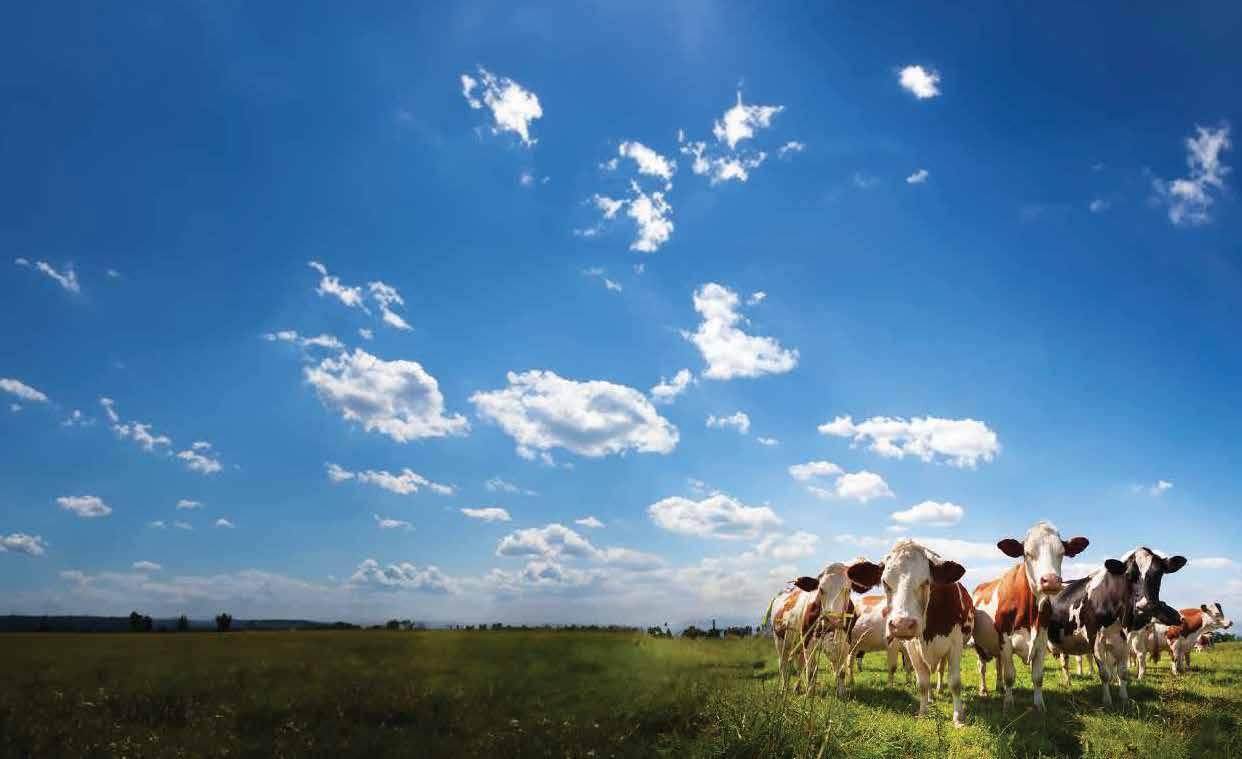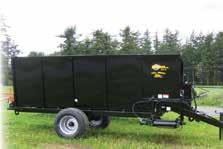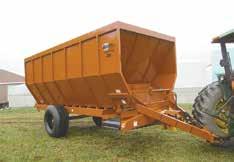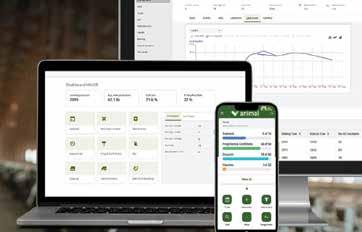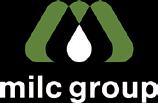









March 8, 2025
Central Plains Dairy Expo brings trade show, entertainment, seminars
By Meghan Kropp meghan.k@dairystar.com
SIOUX FALLS, S.D.
More than two days lled with educational and networking opportunities will be coming to Sioux Falls again this year as the Central Plains Dairy Expo is set for the end of March.
“We’re very excited to be offering it again this year,” said Renee Brod, CPDE director of member services. “It is one of the area’s largest dairy-focused expos, bringing together dairy farmers, industry experts and key stakeholders. It’s a really exciting event that focuses exclusively on the dairy industry.”
The expo begins Tuesday, March 25, at the Denny Sanford Premier Center with the I-29 Moo University offering a dairy beef

A endees walk through the trade show at Central Plains Dairy Expo in Sioux Falls, South Dakota. There will be almost 300 exhibitors at this year’s CPDE.
short course. Registration for this course is separate from registration for the expo, Brod said. To register for the course, attendees are
encouraged to visit the I-29 Moo University website. Doors open at 5 p.m. for the welcome reception on Tuesday, which will include
a conference hosted by Zoetis and happy hour hosted by Alltech in the Sheraton Hotel Fontenelle Room. Brod said multiple exhibi-
tors and sponsors will be hosting a hospitality suite in the Sheraton ballroom.
ISSN Print: 2834-619X • Online: 2834-6203
522 Sinclair Lewis Ave. Sauk Centre, MN 56378
Phone: 320-352-6303 Fax: 320-352-5647 www.dairystar.com
Published by Star Publications LLC
General Manager/Editor
Mark Klaphake - mark.k@dairystar.com
320-352-6303 (ofce)
320-248-3196 (cell) 320-352-0062 (home) Ad Composition - 320-352-6303
Nancy Powell nancy.p@dairystar.com
Karen Knoblach karen.k@star-pub.com
Annika Gunderson annika@star-pub.com
Editorial Staff
Stacey Smart - Assistant Editor 262-442-6666 • stacey.s@dairystar.com
Danielle Nauman - Staff Writer 608-487-1101
danielle.n@dairystar.com
Dan Wacker - Staff Writer 608-487-3858 dan.w@dairystar.com
Tiffany Klaphake - Staff Writer 320-352-6303 tiffany.k@dairystar.com
Amy Kyllo - Staff Writer amy.k@star-pub.com
Emily Breth - Staff Writer emily.b@star-pub.com
Sarah Middendorf - Staff Writer sarah.m@star-pub.com
Advertising Sales Main Ofce: 320-352-6303 Fax: 320-352-5647
Deadline is 5 p.m. of the Friday the week before publication Sales Manager - Joyce Frericks 320-352-6303 • joyce@saukherald.com
National Sales Manager - Laura Seljan (National Advertising, SE MN) 507-250-2217 • fax: 507-634-4413 laura.s@dairystar.com
Assistant Sales Manager - Kati Schafer (Northeast WI and Upper MI) 920-979-5284 • kati.s@dairystar.com
Adam McClary (SW MN, NW Iowa, South Dakota) 605-951-5270 • adam.m@dairystar.com
Mike Schafer (Central, South Central MN) 320-894-7825 • mike.s@dairystar.com
Hannah Ullom (Western Wisconsin) 715-933-4045 • hannah.u@dairystar.com
Julia Merten (Southeast MN and Northeast IA) 507-438-7739 • julia.m@star-pub.com
Bob Leukam (Northern MN, East Central MN) 320-260-1248 (cell) bob.l@star-pub.com
Mark Klaphake (Western MN) 320-352-6303 (ofce) • 320-248-3196 (cell)
Deadlines
The deadline for news and advertising in the Dairy Star is 5 p.m. Friday the week before publication.
One

A�endees interact with exhibitors at the Central Plains Dairy Expo in Sioux Falls, South Dakota. In addi�on to the trade show, there will be 70 speaker sessions for a�endees, some of which will be offered in Spanish.
RaeLynn, a two-time Academy of Country Music new female vocalist nominee who is currently on tour with Jason Aldean, Nate Smith and Dee Jay Silver, will be this year’s performer. Brod recommended visiting the CPDE website to register ahead of time for a name badge. Name badge registration is free for producers. Expo doors open early on Wednesday, March 26. Attendees can nd their seats for the prayer breakfast at 6:30 a.m., with the program beginning at 7 a.m. The breakfast is free for attendees. All that is required is the name badge.
This year’s featured speaker is Rob Roozeboom, who founded RISE Ministries in 2001 and later launched RiseFest, an annual Christian music festival in northwest Iowa.
“He’s going to share his story to inspire people to nd hope and worth amidst brokenness,” Brod said. “He will be a fantastic speaker. We are looking forward to having him. I love that our prayer breakfast community nds people who are local, within our region, to come and provide these inspirational stories.”
The tradeshow oor will be open from 8:30 a.m. to 5:30 p.m. on Wednesday and will be open again from 8 a.m. until 3 p.m. on Thursday, March 27. Brod said there will be almost 300 exhibitors at this year’s expo with the newest exhibitors typically setting up in the arena.
topics this year range from managing milk prices to young stock monitoring to on-farm sustainability, all the way to practical things your employees can do for biosecurity. It’s really cool to have a lot of new topics that are going to be discussed this year.”
Attendees will be able to sit in on more than 70 speaker sessions over the two and half days at the expo. Eight of the sessions will be offered in Spanish.
Brod said one of the highlights this year is the Ed Shed, which will offer short presentations for attendees.
“Ed Shed sessions are quick hits on what you can do to help your farm immediately with some of the different topics that we have there,” she said.
“We have great companies representing all different aspects of the dairy industry,” she said. “Breakout session Turn to PREVIEW | Page 4

Subscriptions
56378-1246. ©

















“One of the key elements of the expo is to provide educational programming, so offering this wide range of sessions and presentations on these topics — like sustainability, innovative dairy farming, herd management and product development — is really important for us. It’s one of the crucial things we do at the expo.”
Another highlight Brod said is the scholarships the Central Plains Dairy Foundation will be offering. This year, three new scholarships, along with the Tonneson Scholarship will be given.
“All funding for our foundation comes directly from the expo,” Brod said. “The foundation board this year decided that they wanted to help our students who are looking for scholarships in the dairy industry. We’re excited about this opportunity the CPDF is
able to provide, especially to students who want to be in the dairy industry.”
Brod said the foundation continues to invest in the CPDE area dairy industry by introducing new scholarships. The newest scholarships will offer $5,000 to three college or university students who have completed at least one semester of post-secondary education and are pursuing a degree in agriculture with an emphasis in the dairy industry. Scholarship applications can be found on the CPDE website.
“We’re looking forward to this year’s event and the incredible opportunities it’s going to provide for the dairy community,” she said. “It’s a fantastic chance to collaborate, learn and grow together as an industry.”
“Breakout session topics this year range from managing milk prices to young stock monitoring to onfarm sustainability, all the way to practical things your employees can do for biosecurity. It’s really cool to have a lot of new topics that are going to be discussed this year.”
RENEE BROD, CPDE DIRECTOR OF MEMBER SERVICES









Country music sensation RaeLynn will bring her signature charm and chart-topping hits to the Central Plains Dairy Expo on March 25, in Sioux Falls, South Dakota. A two-time Academy of Country Music New Female Vocalist nominee, RaeLynn has made waves in country music with her distinctive storytelling and vibrant personality.
The CPDE concert starts at approximately 7 p.m. Prior to the concert, CPDE will host its welcome reception, which starts at 5 p.m., in the Denny Sanford Premier Center. The free welcome reception features hearty appetizers, 800 pounds of cheese served charcuterie style and, of course, ice cream – offered in numerous avors.
These events are free to dairy producers, but registration is required. CPDE organizers encourage dairy producers to register before the event to avoid long lines and signicant wait
times.
RaeLynn has captivated fans with her emotional ballad, “Funny Girl,” which dropped in March 2024. This single marks a signicant milestone in her musical journey, highlighting her evolution as an independent artist dedicated to authenticity.
Over the past decade, RaeLynn has built a diverse career, from publishing a children’s book, “Raisin’ Me A Country Girl,” to becoming the rst country artist to partner with global beauty brand Too Faced Cosmetics and making her acting debut in Hallmark Channel’s “A Nashville Christmas Carol.”
With more than 2.8 million followers across her social media platforms, RaeLynn boasts both Gold — “Love Triangle” and “Lonely Call” — and Platinum — “God Made Girls” — singles, while amassing more than 1 billion career streams.



Tues., March 25, 2025 • 9:00 am – 3:15 pm
Denny Sanford Premier Center • Sioux Falls, SD
9:00 am Registration - Taylor Leach Hildebrandt Assistant Editor with Dairy Herd Management will MC
9:30 am Update on Implants - Zachary Smith, SDSU
10:15 am Vaccination management - Jennifer Spencer, Texas A&M
11:00 am Calf management research “preparing ‘em for the feedlot” - Gail Carpenter, ISU
11:45 am Q&A Session - Taylor Leach Hildebrandt, moderating Noon Lunch
12:45 pm What the Dairy Crossbreed Research Is Telling Us About The Feedlot - Garland Dalke, ISU
1:30 pm Economics of BXD In The Feedlot - Melanie Pimentel-Concepcion, MSU
2:15 pm Hoof related Lameness in Feedlot Cattle - Sarah Erickson, TELUS Agriculture
3:00 pm Q&A Session - Taylor Leach Hildebrandt, moderating 3:15 pm Adjourn
• Students $20 Register online at: https://go.iastate.edu/DBSC25


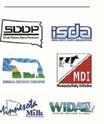















“The
Sako Vandermeer - White, South Dakota
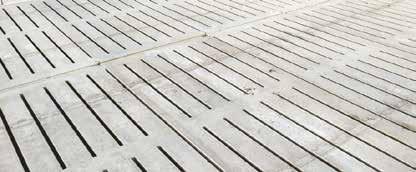
• Engineered for strength and long-term durability
• DRY CAST formulation creates low porosity and slump
• Computerized batching for uniformity
• Robotic mold system provides consistency
• Quality nished for smooth edges and sure footing
•Manufactured in a controlled environment (Steam Beds) for faster curing
• Delivered, professionally leveled and installed
• Strength Compression Tests to exceed quality standards
•Modular design for easy installation











By Michele Ackerman Contributing writer
Cows agree. When it comes to bedding, sand is the gold standard. Nothing beats it for comfort and cleanliness, udder health and traction on concrete said Renee Schrift, director of global sales for agriculture systems at McLanahan Corporation.
But, sand can get expensive. For farmers who have invested in a reclamation system — or are considering one — it behooves them to learn how to recover as much sand as they can for bedding, so they have less to spread on the elds. For dairy farmers considering an anaerobic digester, they must keep in mind that some types of sand must be virtually eliminated from manure.
Sand will be the focus of Schrift’s presentation at Central Plains Dairy Expo in Sioux Falls, South Dakota, March 26 at 11:30 a.m. and March 27 at 8:30 a.m. She will draw from her 24 years of experience with sand separation systems to offer tips for producers who want to improve their reclamation setups or prepare for a potential manure digester.
From the cow standpoint, the cows themselves will tell farmers what kind of sand is best, Schrift said.
“Cows will lay down in stalls where the sand is loose and soft and conforms to their bodies,” Schrift said. “When it is too ne, traps moisture and gets packed and hard, cows are going to tell you that is not a very comfortable stall.”
From a sand recovery perspective, settling characteristics — how easily the sand and manure separate — are paramount Schrift said. In the best-performing systems, at least 90% of sand can be reclaimed, and settling plays a major role in this success.
“We don’t want too many nes, and we don’t want too many coarse particles,” Schrift said. “We




don’t want sand that is so powdery ne that once wet or in the soil, it compacts like concrete. We also don’t want pea-sized sand that could be detrimental to hoof health.”

There are standards for sand gradations that yield high reclamation rates, but they are not the be-all and end-all Schrift said. She said she gives guidelines because farmers have to start somewhere.
“Our view is there is no ‘best’ sand,” she said. “You must consider what works well for your cows and your manure management goals. If you nd sand that moves loosely in the stall and works with the cow and not against her, you will have sand that is pretty good on the separation side as well.”
Producers often have limited control over sand quality, including particle size, because they purchase what is available locally to save on the cost of hauling. This does not mean there are no options for lessthan-desirable sand.
Schrift said there has been a lot of evolution of sand separation systems. How these systems work with sand and how they reclaim it are getting better all the time she said.
“We see dairies bed with really ne sand as well as coarser sands,” Schrift said. “We just need to put in equipment to customize to those situations. We can get high reclamation rates even with these systems.”
Because no two management systems are the same, Schrift said sand reclamation systems cannot be cookie-cutter.
“Manure is what you feed your cows and how much water is entering the system,” Schrift said. “That varies from site to site and from dairy to dairy and is even different regionally. Some dairies want to use more water because they irrigate. Others use hardly any at all.”
An effective sand reclamation system also considers a producer’s goals, which may include a manure digester.
If there is a digester in future plans, Schrift said the sand reclamation system needs to do a better job of getting out the sand that could potentially settle in the digester.
“There are some sands and silts that will probably stay suspended and head to the digester with the manure and cause no issues,” she said. “But there are some that will settle. That is what we want to capture and get that out before it enters the digester.”
She said the industry has not dove into the types of sand and gradations that settle in digesters. This will be a focus of part of her presentation.
Whether planning to install a digester or not, the effort to reclaim cleaner sand improves milk quality and cow health, reduces the budget for virgin sand and minimizes the need to haul sand to the elds.
“The goal should always be to get as much sand out, make a quality product and get a good return on investment,” Schrift said. “All of those things determine what the system is going to look like at the end of the day.”
High Sand Reclamation: What Types of Sand Work Best?
March 26 at 11:30 a.m. in MR 8 and March 27 at 8:30 a.m. in MR 3




3x4 Bales • 1st, 2nd & 3rd Cutting Hay WE



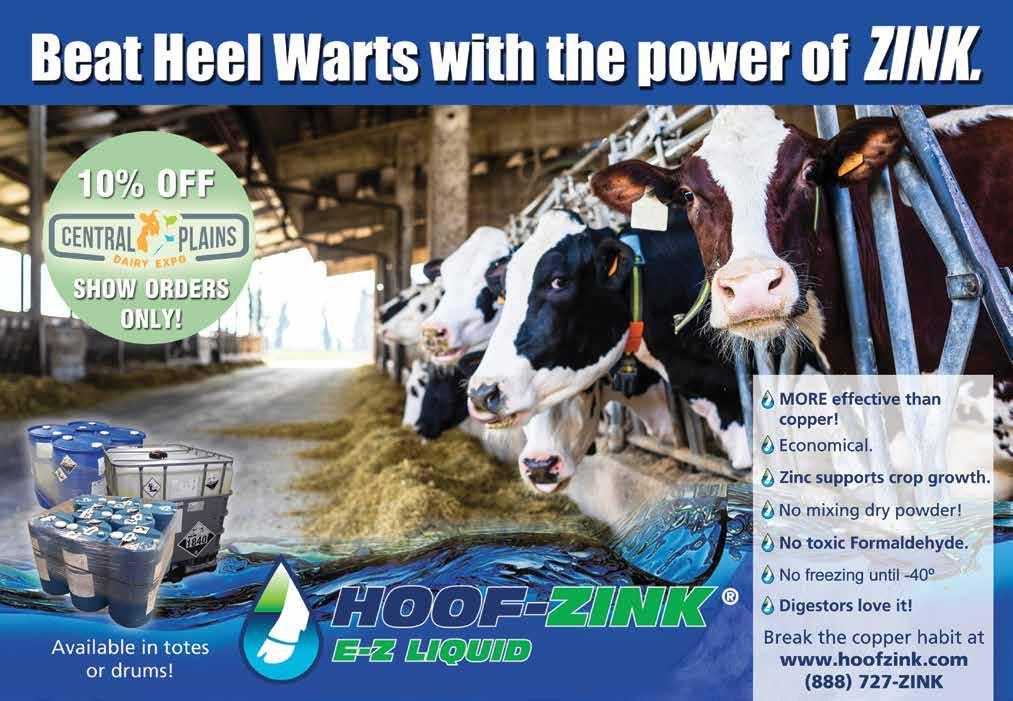


By Sarah Middendorf sarah.m@star-pub.com
Dry matter intake can have a positive and a negative impact on a cow’s productivity, health and overall performance said Ron Van Beek, CEO and founder of Van Beek Natural Science.
Van Beek will be presenting “From Data to Impact: Maximizing Dry Matter Intake for Optimal Performance” March 26 at 3:30 p.m. and March 27 at 9 a.m. at the Central Plains Dairy Expo in Sioux Falls, South Dakota.
During his presentation, Van Beek will talk about the topics of palatability, dry matter intake, and mold and wild yeast growth in dairy cattle feed, among others.
may eat fresh food more often than dayold food or week-old food.
“If we have a fresh baked loaf of bread in front of us, we will probably eat two slices,” Van Beek said. “If we have a slice of bread that’s been lying on the counter for six hours, we will probably only eat one slice. If we have a slice of bread … that smells like mold we will probably eat a half or less.”
This analogy connects back to the benets of having freshly mixed feed that has not been in the bunk for an extended period of time Van Beek said. Fresh feed appeals to animals just as it does to people. Van Beek said if he were to ask someone who already had dinner, “Are you hungry?” they would say, “No.”

“If somebody walked in the room behind you with a freshly baked plate of cinnamon rolls within a minute you would start smacking your lips and salivating,” Van Beek said. “(In) another minute you wouldn’t care what I’m saying. You’d be looking around (at) which is the largest piece (saying) ‘That’s the one I want.’”
“Anytime you can increase dry matter intake, you’re naturally going to have more milk,” Van Beek said. “Anytime you can preserve your feed, you are naturally going to have better health in the cows.”
Van Beek will also provide tips for getting animals to consume the maximum amount of energy possible to drive production. Van Beek said during a 24-hour period, a cow’s energy is divided between digestion, body maintenance, immunity and production.
Being able to offer freshly mixed feed that is maintained in the same state to prevent mold growth is important Van Beek said.
Even though the cinnamon rolls were not seen at rst, the airborne phenols they release stimulated the want for a cinnamon roll Van Beek said. Animals also have this when they smell the feed they want. Their desire to eat more is stimulated.
“That’s the same thing we are going to try to do to livestock,” Van Beek said.
Van Beek has been working on different models to enhance dry matter intake.
March 26 at 3:30 p.m. in room MR 6/7 and March 27 at 9 a.m. in room MR 6/7
“If you don’t do something to prohibit that (mold or yeast) growth, it kills palatability,” Van Beek said. “Plus, the growth itself is utilizing energy that’s not left for the cow. The cow has to deal with the mold, which is hard on the microbiome within the rumen. It’s also hard on the liver and it can cause abortions.”
Cows are able to smell danger before humans are, Van Beek said. To put it in perspective of how humans determine what food they will eat, he said humans

“(We worked) to create a stronger appetite by using plant phenols and by preserving feed from molds and yeast,” Van Beek said. “That’s giving the cow the ability to milk closer to (their) genetic potential.”
Keeping dry matter intake in mind when feeding animals can lead to better health, productivity and overall performance as an animal.
“If (farmers) spend the money they do preparing the feeds … to feed the cows, why wouldn’t (they) want to get the maximum return?” Van Beek said. “If (farmers) spend money on genetics for having the best herd, why wouldn’t (they) want (cows) to perform to their maximum potential?”






































By Sherry Newell Staff Writer
There are many things that come together to make a farm run smoothly. And though it is important to control insects, the effort to get rid of ies in the milking parlor is not always high on the list of things to do.
That is the dilemma explained by Anna Hansen, a technical services support specialist for McLaughlin Gormley King Company. She will present a session March 26 at 11 a.m. and March 27 at 1 p.m. called “The Power of Multiple Modes of Action for Pest Control” at the Ed Shed at Central Plains Dairy Expo in Sioux Falls, South Dakota.




Paul@adaent.net •



Anna Hansen McLaughlin Gormley King Company
“It’s so easy to push (pest control) down on the rung of priorities,” Hansen said. “But the reality is that insects cause a lot of damage. There are economic losses that come with uncontrolled populations.”
Hansen said she chose the topic because knowledge about how insecticides work is not at the forefront of all dairy farmers’ brains. Her presentation will include background on how insecticides work and how the insect ghts the effort to be controlled.
“It’s a little biology and a little of how on earth you choose (an insecticide), given the huge variety of products on the market,” she said.
Hansen’s session will focus primarily on y control, where she said the most important component is sanitation. She cited calf hutches as an example, calling the area around them “maggot heaven.” The spilled feed and moisture make an ideal environment for ies.
She said farm cleanup can make a big difference in y control before considering various insecticides.
Many of the products for pest control have overlapping active ingredients, but the formulation lends itself to various controls she said. Using the same active ingredient over the years may help pests develop immunity.
“That’s when you bring in another ingredient— target a different site on the insect body,” she said. “Flies do overwinter and there is constantly an inux. So you know they can build up resistance and you have to battle harder.”
Hansen’s session will provide concrete steps for building a y control protocol on a dairy farm. A recommend protocol starts with a walk around the farm, an inspection, and then an understanding of which type of y is present and at what level of population.
Identifying which species of y is impacting the dairy is important, she said. Her session will focus on four of the many species of the insect.
“From a distance (ies) look similar to one another,” she said. “But look at where they are going on a cow’s body.”
For example, stable ies are attracted to cows’ legs, while face ies are around the noses and mouths, and horn ies crowd on their backs. House ies are more of a general nuisance, Hansen said. Identication matters because it can allow producers to focus their sanitation efforts. Immature ies found around the calf hutches and other soiled media are often house ies and stable ies, while face ies and horn ies lay eggs in fresh manure.
“It’s not realistic to say there will never be ies on my farm, but once you’ve identied the main problems, you can establish an action threshold,” Hansen said.
A good monitoring program, according to Hansen, will tell a dairy farmer when to take action.
“It’s easier to deal with them when activity is picking up rather than later,” she said.
The nal steps in a farm’s protocol are guring out how long to wait before evaluating the effort and knowing what to look for when doing that.
In the meantime, she points out the variety of resources available to help dairy farmers manage their pest management efforts, citing extension as well as livestock specialists who understand pest control.



















Heat treated, mechanically extracted soybean meal
Excellent protein and energy source for lactating cows
High in intestinallydigestible, rumen undegradable (bypass) protein
Higher metabolizable energy than solvent extracted soybean meal products
Palatable to cows - all plant protein, no animal protein component
All natural, chemical-free process
To improve reproduction and reduce stress
To assist immune function and reduce inflammation



Privately held company with excellent customer service

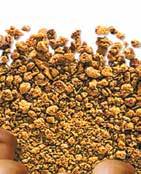









































































TUESDAY, MARCH 25
5:00 PM Welcome Reception, Doors Open 9:00 PM Sheraton Hospitality Room
WEDNESDAY, MARCH 26
6:30 AM Doors Open
7:00 AM Ag Prayer Breakfast Program Begins
8:30 AM Trade Show Floors Open
8:30 AM-5:30 PM Free Donuts, Free Grilled Cheese, Free Ice Cream Treats 11:00 AM-4:30 PM Beer Garden Open
8:30-9:30 AM BREAKOUT SESSIONS
Dry Off: A New Beginning or End of the Line?
- Chris Rock (Sponsired by AHV USA) MR 8
Optimizing Calf Health: Strategies for Management, Nutrition and Immunity - Minnie Ward (Sponsored by Feedworks) MR 12
U.S. Genetic Progress – Where Did We Gain and Where Did We Fall Short!? - David Erf (Sponsored by Zoetis) MR 3
9:00-9:30 AM ED SHED SESSION: Shedding Light on Stray Voltage: Understanding and Solving a Hidden Dairy Challenge - James Neawedde Jr.(Sponsored by Zero Tolerance/Current Defense) Ed Shed
9:00-10:00 AM BREAKOUT SESSIONS
Setting Up Calves for Success Before Birth Through Dam Nutrition - Billy Brown (Sponsored by Balchem) MR 9/10
Credit for Good: Producer Pathways to Profit for Sustainable Practices - Kevin Dhuyvetter & Sara Kvidera (Sponsored by Elanco) MR 13
9:30-10:30 AM BREAKOUT SESSIONS
Commodity Price Risk Management – Protect Your Bottom Line - Mark Newman (Sponsored by CIH) MR 6/7
Advantages of Rotary Milking - Jeff Hahn (Sponsored by DeLaval) MR 14
Elevate Your Dairy Operation with New Innovations from VAS - Dylan Ash & Meagan Young (Sponsored by VAS)
10:00-11:00 AM BREAKOUT SESSIONS
Calf Scours Continues to be a Prevailing Problem in Calves... A New Treatment Strategy Proves Successful!
MR 1/2
- Dr. Michael Nagorske (Sponsored by TechMix, LLC) MR 8
Goldilocks: How Much Gut Health Technologies is ‘Just Right’? - Jill Soderstrom (Sponsored by Land O’Lakes) MR 12
10:00-10:30 AM ED SHED SESSION: Cool Cows, Thriving Herds: Advanced Heat Mitigation Techniques - Bill Stone (Sponsored by Diamond V) Ed Shed
10:30-11:30 AM BREAKOUT SESSIONS
Growing Again: A Look at the Dairy Markets in 2025
11:30 AM-12:30 PM BREAKOUT SESSIONS
The Future of Calf Care - Andrew Beckel & Dagmar Beckel Machyckova (Sponsored by Golden Calf) MR 13 High Sand Reclamation: What Types of Sand Work Best? - Renee Schrift (Sponsored by McLanahan Corporation) MR 8
12:00-1:00 PM BREAKOUT SESSIONS
Managing Milk Prices in 2025 - Katie Burgess (Sponsored by Ever.Ag) MR 12
SPANISH SESSION: Milk Quality, Mastitis and Parlor Interactions - Jorge Luna (Sponsored by Zoetis) MR 9/10
12:00-12:30 PM ED SHED SESSION: Turning Waste into Wealth: Transforming Farm Manure into a Low-cost Fertigation Asset for In-season application with Drip Irrigation - Kurt Grimm (Sponsored by NutraDrip Irrigation Systems) Ed Shed
12:30-1:30 PM BREAKOUT SESSIONS
It Starts with the Bugs: Optimizing Rumen Development in Dairy Calves - Craig Louder (Sponsored by Axiota Animal Health) MR 14
Youngstock Monitoring: Insights Gained and Future Opportunities - Sarah Anderson (Sponsored by Merck Animal Health) MR 1/2
Navigating Uncertainty: Guiding Producers Through Transition with Confidence - Rena Striegel (Sponsored by CPDE Future Connections) Denny Sanford Premier Center
1:00-2:00 PM BREAKOUT SESSIONS
To 7 Pounds and Beyond – Maximizing Milk Components for Profitability - Michael Hutjens (Sponsored by Quality Liquid Feeds, Inc.) MR 3
Ultraplus Sex Sorted Semen: Huge Technology Packed in a Tiny Straw - Eric Zwiefelhofer (Sponsored by Stgenetics) MR 8
Learnings and Implementation of On-farm Sustainability
Reporting - Lucas Sjostrom, Michael Crinion, Jamie Fisher (Sponsored by Edge Dairy Farmer Cooperative) MR 13 1:00-1:30 PM ED SHED SESSION: Forage 360: Producing Forage Year Round - Jeff Jackson (Sponsored by Land O’Lakes) Ed Shed 1:30-2:30 PM BREAKOUT SESSIONS
Practical Insights for Managing Transition Cow Inflammation - Tim Doherty (Sponsored by Form-A-Feed) MR 6/7
SPANISH SESSION: The Importance of Your Role as a Dairy Worker in the Sustainability of the Dairy Industry - Jorge Delgado (Sponsored by Alltech) MR 9/10 2:00
2:00-3:00 PM The Power of the Female - Chelsea Abbott (Sponsored by Trans Ova Genetics) MR 1/2 Avian Influenza: Protecting Farms and Industry in the Face of HPAI Threats - Dr. Matt Hille (Sponsored by CPDE) Denny Sanford Premier Center 2:00-2:30
- Sarina Sharp (Sponsored by Farm Credit) Denny Sanford Premier Center Unleashing the Power of Alfalfa in Your Cropping System – A Fireside Discussion - Erika Rodbell (Sponsored by Forage Genetics International)
MR 3
SPANISH SESSION: Enhancing Biosecurity on Dairy Farms: Practical Tips for Dairy Workers - Maristela Rovai & Noelia Silva del Rio ( Sponsored by SDSU) MR 9/10
11:00 AM-12:00 PM BREAKOUT SESSIONS
Prevention and Treatment of Subclinical Hypocalcemia to Optimize Health and Reproduction in Dairy Cattle
- Claira Seely (Sponsored by Phibro Animal Health) MR 14
Maximizing the Profit Centers Within your Feed Management System - Keith Sather (Sponsored by Supervisor Systems) MR 6/7
Do High Oleic Soybeans Fit Your Farm? Research and Producer Panel Discussion - Kevin Harvatine, Nathan Brandt, Tim Hood (Sponsored by Vita Plus Corp.) MR 1/2
11:00-11:30 AM ED SHED SESSION: The Power of Multiple Modes of Action for Effective Pest Control
- Anna Hansen (Sponsored by MGK) Ed Shed 11:00
SCHEDULE OF EVENTS SUBJECT TO CHANGE
The Evolving Dairy Landscape: Addressing Cow Health, Environmental Impacts and Economic Pressures - Luke Miller (Sponsored by Alltech) MR 3 The Sweet Spot: How Molasses Complements Adult Cow Rations - Gail Carpenter (Sponsored by Westway Feed Products) MR 8
3:00-4:00 PM SPANISH SESSION: The 7 Pillars for Raising a Healthy Calf - Tiago Tomazi (Sponsored by Merck Animal Health) MR 9/10
3:30-4:30
Optimizing Herd Productivity and Health: Advanced Transition Cow Management and Nutrition Strategies - Ruby Wu (Sponsored by Arm & Hammer Animal Nutrition) MR 1/2 From Data to Impact: Maximizing Dry Matter Intake for Optimal Performance - Ron Van Beek (Sponsored by Van Beek Natural Science) MR 6/7 4:30 PM Wine & Cheese Social on the Trade Show Floors
5:30-10:00 PM Dairy Checkoff and State Trade Association Networking Reception (Sponsored by Midwest Dairy) MR 12/13/14 5:30 PM Trade Show Floors Close
THURSDAY, MARCH 27
8:00 AM Trade Show Floors Open
8:00-10:00 AM FREE Pancake Breakfast
8:00-9:00 AM BREAKOUT SESSIONS
It Starts with the Bugs: Optimizing Rumen Development in Dairy Calves - Craig Louder (Sponsored by Axiota Animal Health) MR 1/2
The Dairyman’s Perspective of the Feed Market Outlook and Dairy Margins - Jenny Wackershauser (Sponsored by Ever.Ag) MR 9/10
The Power of the Female - Chelsea Abbott (Sponsored by Trans Ova Genetics) MR 12
8:30-9:30 AM BREAKOUT SESSIONS
Optimizing Herd Productivity and Health: Advanced Transition Cow Management and Nutrition Strategies - Ruby Wu (Sponsored by Arm & Hammer Animal Nutrition) MR 13
High Sand Reclamation: What Types of Sand Work Best?
- Renee Schrift (Sponsored by McLanahan Corporation) MR 3
The Sweet Spot: How Molasses Complements Adult Cow Rations - Gail Carpenter (Sponsored by Westway Feed Products) MR 8
9:00-10:00 AM From Data to Impact: Maximizing Dry Matter Intake for Optimal Performance - Ron Van Beek (Sponsored by Van Beek Natural Science) MR 6/7
9:00-9:30 AM ED SHED SESSION: Forage 360: Producing Forage Year Round - Jeff Jackson (Sponsored by Land O’Lakes) Ed Shed
9:30-10:30 AM BREAKOUT SESSIONS
Advantages of Rotary Milking - Jeff Hahn (Sponsored by DeLaval) MR 12 Do High Oleic Soybeans Fit Your Farm? Research and Producer Panel Discussion
- Kevin Harvatine, Nathan Brandt, Tim Hood (Sponsored by Vita Plus Corp.) MR 1/2
SPANISH SESSION: The 7 Pillars for Raising a Healthy Calf - Tiago Tomazi (Sponsored by Merck Animal Health) MR 9/10
10:00-11:00 AM BREAKOUT SESSIONS
The Evolving Dairy Landscape: Addressing Cow Health, Environmental Impacts and Economic Pressures
- Luke Miller (Sponsored by Alltech) MR 8 Practical Insights for Managing Transition Cow Inflammation - Tim Doherty (Sponsored by Form-A-Feed) MR 3
U.S. Genetic Progress – Where Did We Gain and Where Did We Fall Short!? - David Erf (Sponsored by Zoetis) MR 13
10:00-10:30 AM ED SHED SESSION: SRP Technology and an Experimental Salmonella Dublin Vaccine - Dr. Jason Anderson (Sponsored by Vaxxinova) Ed Shed
11:00AM-3:00 PM Beer Garden Open
11:00 AM-1:00 PM Free Grilled Cheese Sandwiches
11:00 AM-12:00 PM BREAKOUT SESSIONS
Setting Up Calves for Success Before Birth Through Dam Nutrition - Billy Brown (Sponsored by Balchem) MR 6/7
Youngstock Monitoring: Insights Gained and Future Opportunities - Sarah Anderson (Sponsored by Merck Animal Health) MR 1/2
Calf Scours Continues to be a Prevailing Problem in Calves... A New Treatment Strategy Proves Successful!
- Dr. Michael Nagorske (Sponsored by TechMix, LLC) MR 12
SPANISH SESSION: The Importance of Your Role as a Dairy Worker in the Sustainability of the Dairy Industry
- Jorge Delgado (Sponsored by Alltech) MR 9/10
11:00-11:30 AM ED SHED SESSION: Shedding Light on Stray Voltage: Understanding and Solving a Hidden Dairy Challenge - James Neawedde Jr. (Sponsored by Zero Tolerance/Current Defense) Ed Shed
11:30 AM-12:30 PM BREAKOUT SESSIONS
To 7 Pounds and Beyond – Maximizing Milk Components for Profitability - Michael Hutjens (Sponsored by Quality Liquid Feeds, Inc.) MR 3
Ultraplus Sex Sorted Semen: Huge Technology Packed in a Tiny Straw - Eric Zwiefelhofer (Sponsored by Stgenetics) MR 8 Learnings and Implementation of On-farm Sustainability
Reporting - Lucas Sjostrom, Michael Crinion, Jamie Fisher (Sponsored by Edge Dairy Farmer Cooperative) MR 13
12:00-12:30 AM ED SHED SESSION: Cool Cows, Thriving Herds: Advanced Heat Mitigation Techniques - Bill Stone (Sponsored by Diamond V) Ed Shed
12:30-1:30 PM BREAKOUT SESSIONS
Maximizing the Profit Centers Within your Feed Management System - Keith Sather (Sponsored by Supervisor Systems) MR 6/7
Elevate Your Dairy Operation with New Innovations from VAS - Dylan Ash & Meagan Young (Sponsored by VAS) MR 1/2
Goldilocks: How Much Gut Health Technologies is ‘Just Right’? - Jill Soderstrom (Sponsored by Land O’Lakes) MR 12
SPANISH SESSION: Enhancing Biosecurity on Dairy Farms: Practical Tips for Dairy Workers - Maristela Rovai & Noelia Silva del Rio (Sponsored by SDSU) MR 9/10
1:00-2:00 PM BREAKOUT SESSIONS
Credit for Good: Producer Pathways to Profit for Sustainable Practices - Kevin Dhuyvetter & Sara Kvidera (Sponsored by Elanco) MR 8 Prevention and Treatment of Subclinical Hypocalcemia to Optimize Health and Reproduction in Dairy Cattle - Claira Seely (Sponsored by Phibro Animal Health) MR 13
Unleashing the Power of Alfalfa in Your Cropping System – A Fireside Discussion - Erika Rodbell (Sponsored by Forage Genetics International)MR 3
1:00-1:30 PM ED SHED SESSION: The Power of Multiple Modes of Action for Effective Pest Control - Anna Hansen (Sponsored by MGK) Ed Shed
1:00 PM Free Ice Cream
2:00-3:00 PM BREAKOUT SESSIONS
Dry Off: A New Beginning or End of the Line? - Chris Rock (Sponsored by AHV USA) MR 6/7
Optimizing Calf Health: Strategies for Management, Nutrition and Immunity - Minnie Ward (Sponsored by Feedworks) MR 1/2 The Future of Calf Care - Andrew Beckel & Dagmar Beckel Machyckova (Sponsored by Golden Calf) MR 12
SPANISH SESSION: Milk Quality, Mastitis and Parlor Interactions - Jorge Luna (Sponsored by Zoetis) MR 9/10
SCHEDULE OF EVENTS SUBJECT TO CHANGE
2:00-2:30 PM
ED SHED SESSION: Turning Waste into Wealth: Transforming Farm Manure into a Low-cost Fertigation Asset for In-season application with Drip Irrigation - Kurt Grimm (Sponsored by NutraDrip Irrigation Systems) Ed Shed
3:00 PM Trade Show Floors Close




Sponsored by Alltech









Sponsored by AMPI, at the Valley Queen Cheese Dairy Bar, located in the Arena’s northeast concession stand

On Wednesday and Thursday in the Arena

On Thursday, March 27, in the Arena at 8:00 a.m.
On Wednesday, March 26, at the Valley Queen Cheese Dairy Bar at 4:30 p.m.
at the Valley Queen Cheese Dairy Bar




















By Dan Wacker dan.w@dairystar.com
Growing and harvesting alfalfa is a Midwest summertime tradition synonymous with baseball and sunshine. At Central Plains Dairy Expo, Dr. Erika Rodbell will host a reside chat to discuss how alfalfa has become the “Queen of Forages” and how it can be used to improve dairy operations. Rodbell, a forage research agronomist at Forage Genetics International, will host two of these reside chats at CPDE in Sioux Falls, South Dakota.
Rodbell, a rst-time presenter at CPDE, will discuss the benets of alfalfa, not just for hay producers, but for dairy farmers and dairy nutritionists, explaining how it can benet dairy operations beyond being a source of feed. Those interested in attending can do so March 26 at 10:30 a.m. or March 27 at 1 p.m. in Room MR3.
“I want people to come to this conversation with questions about alfalfa, with concerns about alfalfa on


their operations and what the agronomic benets are,” Rodbell said. Rodbell’s discussion will delve into three benets of alfalfa: sustainability, pest management and feed.


“When you think about crop rotation, farmers aren’t likely to have a longer-term rotation than the typical two, so what’s a farmer to do,” Rodbell said. “Others suggest a longer, more diverse rotation if you want to outcompete the pest species, and alfalfa allows you to do that.”

Dr. Erika Rodbell Forage Genetics International
Alfalfa is vital to sustainability by stopping nitrate runoff and managing weeds as a perennial crop. Alfalfa’s green matter alive in and on top of the soil during different seasons provides several sustainability benets, including making weed seeds germinate later, shading weeds and limiting weeds before they go to seed or even ower.
Rodbell’s studies in pest management also showed how alfalfa can break pest cycles. She focused on corn rootworm traditionally managed by Bacillus thuringiensis. In August 2024, a lead agronomist released a publication citing that corn rootworm has developed a resistance to the pore-forming crystal, aka Cry, proteins generated from Bt corn.
To manage these pests, Rodbell and her team developed a 4-year crop rotation theory.
Dealing with a pest that has developed a Bt resistance reduces what farmers can use to eradicate them, making management strategies a challenge. Alfalfa has become an economically viable solution to this problem.
Rodbell will also discuss the HarvXtra Alfalfa varieties.
“HarvXtra has a multitude of benets,” Rodbell said. “There’s nutritional exibility, it provides higher protein for wet and dry cows. If you want to be nancially viable, you need to have high protein content.”
HarvXtra also allows for exibility in the harvest window. That is an important detail as dairy operations continue to grow larger, needing more alfalfa and trying to keep production in-house. It provides a unique nutritional package, with high digestibility in its reduced lignin.
With a later harvesting window, the plant can grow longer.
The reduced lignin levels are also a key component to the exibility in the harvest window because of added digestibility.
“Digestibility is something you need to balance when harvesting conventional alfalfa,” Rodbell said. “HarvXtra reduces lignin content for added digestibility.”
Rodbell hopes attendees of her reside chat can walk away with answers to their questions, or resources to learn more about how alfalfa can benet their operation.
Unleashing the Power of Alfalfa in Your Cropping System – A Fireside Discussion
March 26 at 10:30 a.m. and March 27 at 1 p.m. in room MR 3.
“With conventional alfalfa, the harvest window is nite,” Rodbell said. “There are specic windows to get the ideal nutrition. What HarXtra allows you to do is have increased yield potential, without quality loss by waiting to take that hay off.”

By Tiffany Klaphake tiffany.k@dairystar.com
Many things that happen on and off the dairy farm impact the dairy industry.
Luke Miller, dairy technical support specialist with Alltech, will address some of these issues during his breakout session “The Evolving Dairy Landscape: Addressing Cow Health, Environmental Impacts and Economic Pressures” held March 26 at 2:30 p.m. and March 27 at 10 a.m. at the Central Plains Dairy Expo in Sioux Falls, South Dakota.
“It is meant to be a discussion of emerging cow health issues and en-

vironmental concerns,” Miller said. “I don’t put any products into my talks so there is no pressure or sway in my information.”
In Miller’s presentation, he will cover cow health issues, such as Highly Pathogenic Avian Inuenza. He will also cover environmental concerns; economic pressures, such as government subsidies; and markets for methane greenhouse gas emissions.
One of the biggest topics in the dairy industry for the past year has been H5N1. Miller will discuss where the disease has been discovered in the last 30 days, and where it has been over the past year. Because the bird u is mutating, he said it will continue to
be a major concern for farmers.
“It all comes down to, it is not just affecting birds anymore, it is not just affecting cows anymore,” Miller said. “It is affecting humans, so it is a major concern. We are starting to see some of the things that happen to birds happen to humans, and that is not good.”
While vaccines are available, Miller will discuss why some farms choose to vaccinate and some do not.
“I will talk about why we do eradication versus vaccination, what countries do vaccinate, what countries don’t vaccinate, and the pros and cons of each,” Miller said.
The environmental impacts and economic pressures in the dairy industry go hand in hand as they deal with government policies. With recent changes in leadership at the federal level, that means there will be changes to federal policies. In the meantime, there are a lot of questions while the transition settles.
“We are getting questions like, ‘Will my project get funded, will my funding continue, and what subsidies are going to go on?’” Miller said. “What does the (U.S. Department of Agriculture) funding look like and what does the private sector look like? Will that be a strong option in the future?”
Miller said some private companies are still seeking carbon credit opportunities.
“We are selling (carbon credits) credit by credit and brokerages are going out and nding homes for all these credit on a case-by-case basis,” Miller
said. “As this year goes on, we will see who will still be in the market for these types of options.”
Tariff rates and their effect on exports is another factor that has come with the change in leadership, Miller said. A lot more will be determined in the coming months as new staff members are appointed and committees are formed.
One local concern farmers can take control of on their farms is the use of technology. Miller will go over a Top 10 questions to ask technology dealers to determine if a piece of technology is right for their farm. Miller said to ask questions about where these companies are getting their numbers from and their data integrity practices.
These are some of the national and global factors affecting the dairy industry and Miller said he can address other concerns guests may have.
“If something new comes up I can adapt to cover any relevant topic that attendees want to learn more about,” Miller said.
The
March 26 at 2:30 p.m. in room MR 3 and March 27 at 10 a.m. in room MR 8
• Specifically-selected bacteria that work together
• Added enzymes specifically formulated to boost feed efficiency










• Proprietary technology that lasts longer— our bacteria is grown and processed in order to remain stable over longer periods of time.
• Contains potassium sorbate, which starts to work immediately and does not have to compete with epiphytic microbes, and does not depend on acetic acid like Lactobacillus buchneri, a common ingredient in other silage inoculants.





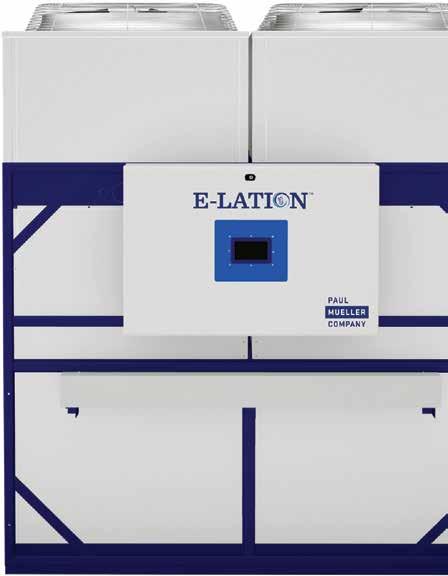
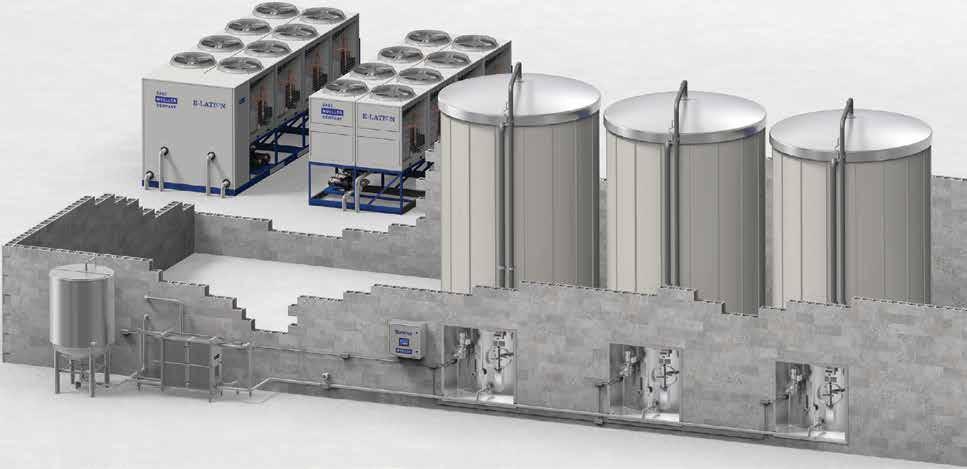
Advanced Dairy Spring Valley, WI; Mondovi, WI; West Salem, WI; Mora, MN; Pierz, MN; Wadena, MN; St Charles, MN
Advanced Dairy Spring Valley, WI; Mondovi, WI; West Salem, WI; Mora, MN; Pierz, MN; Wadena, MN; St Charles, MN
Central Ag Supply Juneau, WI; Baraboo, WI
Central Ag Supply Juneau, WI; Baraboo, WI
Eastern Iowa Dairy Systems Epworth, IA
Eastern Iowa Dairy Systems Epworth, IA
Ederer Dairy Supply Plain, WI
Ederer Dairy Supply Plain, WI
Fuller’s Milker Center Lancaster, WI; Richland Center, WI
Fuller’s Milker Center Lancaster, WI; Richland Center, WI
Gorter’s Clay & Dairy Equipment Pipestone, MN
Gorter’s Clay & Dairy Equipment
J. Gile Dairy Equipment, Inc.
Pipestone, MN
Cuba City, WI
Leedstone
J. Gile Dairy Equipment, Inc.
Cuba City, WI
Melrose, MN; Glencoe, MN; Plainview, MN; Menomonie, WI; Sparta, WI
Leedstone
Melrose, MN; Glencoe, MN; Plainview, MN; Menomonie, WI
Lely Center Monroe Monroe, WI
Lely Center Monroe Monroe, WI
Midwest Livestock Systems
Zumbrota, MN; Renner, SD; Menomonie, WI; Kaukauna, WI; Weston, WI
Midwest Livestock Systems
Zumbrota, MN; Renner, SD; Menomonie, WI; Kaukauna, WI; Weston, WI
Monroe Westfalia Surge Monroe, WI
Monroe Westfalia Surge Monroe, WI
Professional Dairy Services Arlington, WI
Professional Dairy Services Arlington, WI
Redeker Dairy Equipment Brandon, WI
Redeker Dairy Equipment Brandon, WI
Sioux Dairy Equipment Rock Valley, IA; Colton, SD
Sioux Dairy Equipment Rock Valley, IA; Colton, SD
Stanley Schmitz Inc. Chilton, WI
Stanley Schmitz Inc. Chilton, WI
Total Dairy Service Kewaunee, WI
Total Dairy Service Kewaunee, WI
Tri-County Dairy Supply Janesville, WI
Tri-County Dairy Supply Janesville, WI
United Dairy Systems West Union, IA; Monticello, IA
United Dairy Systems West Union, IA; Monticello, IA
4-D AG World/4-D AG Fashion .......................................C810
360 Ag Supply, LLC.....................................................Outside
A1 Development Solutions ..............................................H109
A1 Mist Sprayers .............................................................A513
ABS Global ......................................................................C306
ADA Enterprise Inc. .........................................................A512
Adisseo ............................................................................C328
Archer Daniels Midland Company ...................................C632
Advanced Ag Products ....................................................C804
Afimilk ..............................................................................A306
Ag Processing, Inc. .........................................................C628
Ag Property Solutions ......................................................C706
Ag Tech Business..........................................................AF109
South Dakota Dairy Producers ............................................BB
Agri Feed International, LLC............................................C407
Agri-King, Inc. ..................................................................C404
Agri-Placement Services, Inc. .........................................A103
Agri-Plastics/Agri-Comfort ...............................................C724
AgriSteel USA..................................................................C301
AgroChem USA, LLC ......................................................C703
Agromatic, Inc..................................................................C704
Agropur, Inc. ....................................................................C122
AHV USA .........................................................................C112
Albers Dairy Equipment, Inc. ...........................................C507
Alltech ..............................................................................C415
Amelicor...........................................................................H113
American AGCO Trading Co. ..........................................C629
American Dairymen/Twin Rivers Media ..........................C128
AMPI ................................................................................A400
Anez Consulting, Inc........................................................C633
Animal Health International .............................................C530
Animat Inc......................................................................A1011
Arm & Hammer Animal Nutrition .....................................H102
Armor Animal Health .......................................................C228
Arnolds of Kimball, Inc. ....................................................C433
Artex Manufacturing ........................................................A406
Aurora Pharmaceutical ..................................................A1109
Axiota Animal Health, Inc. ...............................................H111
Balchem Corporation .......................................................C527
Beck’s ..............................................................................A413
BECO Dairy Equipment ...................................................H110
Bio-Vet Inc. ......................................................................H123
Boehringer Ingelheim ......................................................C310
BouMatic..........................................................................C232
Bovine Hoof Adhesives/Glue-U Inc. ................................A219
BoviSync........................................................................A1107
Butler Machinery Company .............................................A803
Byron Seeds, LLC ...........................................................H132
Calf Care & Quality Assurance, National Dairy FARM Program .......................................................................A1210
Calf Star.........................................................................A1113 CalfStart LLC ...................................................................H122
Calf-Tel ...........................................................................C400
Cambridge Technologies.................................................C309
Central Confinement Service LLC ...................................A108
Central Life Sciences............................................................M
Central Valley Dairy Supply Inc. ......................................A402 Novonesis (formerly Chr. Hansen) ..................................C114 CIH/Commodity & Ingredient Hedging, LLC ....................C113
Cloverdale Equipment LLC..............................................A800
Comfort Hoof Care ........................................................A1214
Conewango Products Corp. ..................................................U
Control Solutions Inc. ....................................................A1013
Corteva Agriscience MCS, LLC - Dairyland Seed ..........A600 Countryside Dairy Solutions ............................................C304
CowManager ...................................................................A211
CRV USA.......................................................................A1112
Crystal Creek Natural ......................................................A209
Cumberland Valley Analytical Services ...........................H127
Zero Tolerance/Current Defense .....................................C930
Dairy Farmers of America..............................................AF102
Dairy Star.........................................................................C220
Dairyland Laboratories ....................................................C604
DairyVisor, Inc. ................................................................C307
Dakota Fluid Power .......................................................A1215
Dakota Iron Equipment ................................................Outside
Datamars Livestock .........................................................A116
Dave’s Repair ..................................................................C818
DBC Ag Products & LIRA GOLD Supplements .............A1103
DeHaan, Grabs & Associates, LLC .................................C835
Dellait - Animal Nutrition & Health ............................C100 & B
Deluxe Animal Health ...............................................C610 & C
Development Resources of Iowa, Inc. .............................C700
DLF ..................................................................................C324
Diamond V .......................................................................C402
DM Concrete Grooving ..........................................................Z
Diesel Machinery Inc. ......................................................C828
Doda USA......................................................................A1003
Dordt University .....................................................................L
EASYFIX Livestock Comfort............................................C731
EBJ Livestock Market Inc. ...............................................A214
Edge Dairy Farmer Cooperative ......................................C330
Elanco Animal Health ......................................................C427
Elite Plastic Products, A Division of AmeriLux International.................................................A1104
ENDOVAC Animal Health ...............................................C200 Equipment Blades ...........................................................A315
Essential Water Solutions, Inc. ........................................A405
Ever.ag ............................................................................C300
Everlast Industries ...........................................................C808
Evolution Spray Foam .....................................................A309
Excel Machine & Mfg .......................................................C901
Extrutech Plastics ............................................................A106
Faber’s Farm Equipment .................................................C121
FAMO Feeds, Inc. ...........................................................C702 Farm Inc. .........................................................................C609 Farm Systems .................................................................C313 FarmFirst Dairy Cooperative ...........................................C734 Feedworks USA, Ltd........................................................C511 FERA Diagnostics and Biologicals Corp. ........................C327 Forage Genetics International .........................................C607 Form-A-Feed, Inc. ...........................................................C134 Frontier Mills Inc. .............................................................H125
GEA Farm Technologies Inc. ..........................................C618 GENEX ............................................................................C101 Gingerich Structures, LLC .............................................A1213
Golden Calf Company .....................................................C430
Gorter’s Clay & Dairy Equipment of MN, Inc. ..................C521 Central Plains Lely Centers: Gorter’s Clay & Dairy Equipment; Leedstone; Automated Dairy Specialists NE ..................C318 Hanson Silo Company .....................................................C518
Hatfield Mfg. Inc...............................................................C902
Hawke & Company Ag ....................................................C824
Heart of America DHIA ....................................................H126
Heartland Builders Co. ....................................................C609
Hoard’s Dairyman ..................................................................G
Hoof-Zink .......................................................................A1207
Hoppe Roofing Inc. ................................................................E
Hover Chute ....................................................................C509
Hubbard Feeds Inc. .........................................................C115
Hundertmark Cleaning Systems, Inc. ..............................A511
I-29 Moo University Collaboration ...................................A203
Iowa Area Development Group .......................................C605
J & D Manufacturing ........................................................C905
J. B. Hunt Ag Services...........................................................X
JDJ Solutions...................................................................A115
Jefo Nutrition USA Inc. ....................................................H135
Johnson Concrete Livestock Waterers ............................C904
Johnson Engineering Group, LLC .................................A1108
Jones-Hamilton Co. .......................................................A1014
K2S Engineering Inc. .......................................................C800
Kemin Animal Nutrition & Health .....................................C209 Kooima
Kuhn
Marsh McLennan Agency ................................................C411
MB Nutritional Sciences, LLC ..........................................H100
McFinn Technologies ....................................................A1012
McLanahan ......................................................................C111
MEDA/Chemstar & Milk-Rite USA .................................AF100
Medgene..........................................................................A109
Mensch Mfg .....................................................................C613
Merck Animal Health .......................................................C206
MGK Insect Control Solutions .........................................C602
Micro Technologies and MWI Animal Health ...................C832
CHS .................................................................................C308
Midwest Dairy .................................................................C204
Midwest Dairy Solutions ..................................................C230
Midwest Livestock Systems, LLC ....................................C624
Midwest Sidewalls ...........................................................A415
milc Group .......................................................................C630
Minnesota Department of Agriculture ..............................C303
MN DHIA (MN Dairy Herd Improvement Assoc.) ..........AF104
MTech Dairy Solutions ....................................................C326
Munters............................................................................C935
NDEco / New Direction Equipment Co. ...........................A603
Nebraska State Dairy Association .........................................N
Neogen ..................................................................................H
Norbco .............................................................................C830
North Central Steel Co. ...................................................A307
Northland Farm Systems ...............................................A1003
Northern Plains Forage Association ......................................Q
NovaMeal by Novita Nutrition ..........................................C331
Novus International..........................................................C603
NuAge Builders................................................................H133
Nuhn Industries Ltd. ........................................................A619
NutraDrip Irrigation ..........................................................C510
Nutrient Advisors ...................................................................Y
Osakis Silo Repair DBA: WW Erection ............................C728
OZOLEA RETE AGRICOLA ..................................................T
Parnell Living Science .....................................................A602
PEAK Forage Solutions Inc. ............................................C730 Dairy Coach, LLC. DBA PeopleCor .................................A107
Phibro Animal Health .......................................................C221
Pifer’s Auction & Realty .................................................A1008
Pioneer Seeds .................................................................H101 POET ...............................................................................A412
Polytank Inc. ....................................................................A213
Herd-Boss/Post Equipment Company .............................C826
Post Equipment Company/Herd-Boss .............................C424
PowerLift Doors by Rick’s Welding..................................A414
Poseidon, LLC. ..............................................................A1111
Prairie Farms Dairy..........................................................A305
Prairie Land Ag Supply, Inc. ............................................C235
ProfitPro Ag .....................................................................A206
Progressive Dairy ............................................................H115 Promat .............................................................................A310
PSI Power Washer ................................................................P
Puck Enterprises ...........................................................A1203
QualiTech, LLC................................................................C520
QualiTru Sampling Systems ..........................................A1010
Quality Liquid Feeds, Inc. ................................................C213
Ralco ...............................................................................C409
RDO Equipment Co. ........................................................A806
Real-Tuff, Inc. ..................................................................C302
ReproScan.......................................................................A105
Ridgewater College ...............................................................A
Rippleview Hoof Care, Ltd. ..............................................A204
RMH Jones Equipment..................................................A1110
Safe-Trac Grooving .........................................................C908
Scherer Inc. .....................................................................C502
Schwartz Manufacturing ................................................A1106
Select Sires Member Cooperative .........................C119/H114
Sharp Industries ..............................................................C809
Silostop Agri ..........................................................................I
SIDUMP’R Trailer/The BatchBox ....................................A104
Sioux Dairy Equipment ....................................................C615
Sioux Nation Ag Center .........................................................F
smaXtec Inc. ....................................................................C932
SDSU, College of Ag, Food & Environmental Science ..........K
South Dakota, Governor’s Office of Economic Development...............................................A1206
Soy Best ..........................................................................C226
Specialty Sales, LLC .......................................................A111 Steelwerx, LLC ................................................................C806
Steuart’s Natural Health ..................................................C600 STgenetics.......................................................................C224
Syngenta Enogen ............................................................A110
TechMix, LLC ..................................................................C109
TerraKat LLC ...................................................................A208
The Coburn Company Inc. ..............................................A113 TLAY Dairy Video Sales ..................................................C124
Topcon Agriculture ..........................................................A410

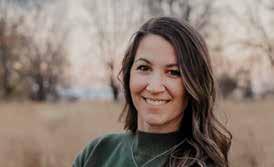




























































































































Wisconsin:

















Abts Equipment LLC
New Franken (920) 866-2485
Gillett (920) 866-2485
Argall Dairy Systems, Inc.
Belleville (608) 424-6110
Platteville (608) 348-3385
Fuller’s Milker Center LLC
Lancaster (608) 723-4634
Richland Center (608) 723-4634
Gehring Sales & Service, Inc.
Rubicon (262) 673-4920
Joe’s Refrigeration, Inc.
Withee (715) 229-2321
Leedstone, Inc.
Menomonie (866) 467-4717
Midwest Livestock Systems
Menomonie (715) 235-5144
Redeker Dairy Equipment
Brandon (920) 960-9260
The Scharine Group Inc.
Whitewater (608) 883-2880
Tri-County Dairy Supply Inc.
Janesville (608) 757-2697 Iowa:
Decorah (563) 382-8722







Minnesota:
Gorter’s Clay & Dairy Equipment, Inc.
Pipestone (507) 825-3271
Leedstone, Inc.
Melrose (888) 267-2697
Glencoe (877) 864-5575
Plainview (800) 548-5240
Midwest Livestock Systems
Zumbrota (507) 732-4673
South Dakota:
Midwest Livestock Systems
Renner (605) 274-3656
music, Roozeboom shares the gospel message with thousands of people in Iowa, South Dakota and Minnesota.
Roozeboom also serves as the Christian Festival Association chairman, hosts the podcast “Enjoying the Journey” and produces annual Christmas and Easter TV programs and “Stories of Strength,” a video series with real-life stories of overcoming adversity through Jesus.

Be prepared to walk away inspired from this year’s Central Plains Dairy Expo Prayer Breakfast as Rob Roozeboom — a Jesus-follower, husband, dad, evangelist, speaker, podcaster and author — shares his “Broken – still chosen” journey. Roozeboom strives to inspire people to nd hope and worth amidst brokenness. The breakfast will be held March 26 at the Denny Sanford Premier Center in Sioux Falls, South Dakota.
As a young child, Roozeboom dreamt of becoming an athlete and farmer. A muscular dystrophy diagnosis at age 5 crushed those dreams. Feeling painfully different and forgotten, Roozeboom questioned his very existence and wrestled with God about his future. God had bigger dreams for Roozeboom.
In 2001, Roozeboom founded RISE Ministries and in 2005 he launched RiseFest, an annual Christian music festival in northwest Iowa that features some of the nation’s top Christian artists and speakers.
Living with muscular dystrophy has given Roozeboom a unique and relatable perspective on walking through adversity while holding onto faith. His authenticity connects with and encourages people from all walks of life. He is a sought-after speaker who shares his story and delivers Jesus’ message of hope to communities, businesses and prominent events nationwide. He has shared the stage with Phil Wickham, For King + Country, TobyMac, Skillet, Lecrae, Anne Wilson, Jep Robertson, Megan Fate Marshman and Darryl Strawberry.
In 2022, Roozeboom and the RISE team created RISE with Rob and Friends to bring singer-songwriters together for storytelling and music. Inspired by Nashville Writers’ Rounds, artists perform their original songs and share how they were inspired. Through this night of hope through storytelling and
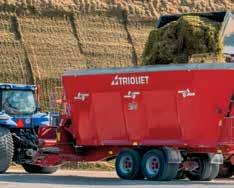

Recently, Roozeboom wrote his rst book, “Broken Still Chosen.” It weaves Roozeboom’s inspiring story with biblical teaching, offering hope to those who feel broken, unloved, unseen or forgotten.
The CPDE Prayer Breakfast is free to dairy producers, but registration is required.


Start your day on Wednesday, March 26, at the Central Plains Dairy Expo Trade Show with the Ag Prayer Breakfast. The breakfast buffet in the Sanford Premier Center will open at 6:30 a.m.


















Real-time alerts ensure each calf gets the attention it needs, leading to timely interventions, lower treatment intensity, reduced reliance on antibiotics, and improved labor efficiency. Powered by Artificial Intelligence and continuously evolving algorithms, the system adapts to your specific farm and the unique behavior of each calf.
With CowManager's Lifetime Monitoring system, you can support the full lifecycle of your herd - from calf to cow - ensuring optimal health, growth and performance at every stage.






Implement the technology designed to optimize calf rearing and maximize future herd health and productivity. Youngstock Monitor uses lightweight ear sensors to track crucial development stages, helping you improve calf health and welfare now for a strong, productive herd later.

By Stacey Smart stacey.s@dairystar.com
Feed costs loom large on many dairies. Therefore, when targeting areas for potential savings, feed is often a top consideration. Carefully managing the purchase of this high-price tag item and buying at opportune times can help control feed costs.
Jenny Wackershauser, a senior dairy analyst and a Feed Foundations program advisor at Ever.Ag, has extensive experience in dairy risk management and feed and grain risk management. During her session at Central Plains Dairy Expo, “The Dairyman’s Perspective of the Feed Market Outlook and Dairy Margins,” Wackershauser will help dairy producers learn how to manage price risks related to the grain market. The session will be held March 26 at noon in room MR 12 and March 27 at 8 a.m. in room MR 9/10.
Wackershauser will share a look back on feed and grain markets over the last years to explain how recent historically high prices came about. She will discuss the tools available for managing these higher prices, such as cash markets and futures contract options. In addition, she will provide an outlook on
the grain market for the year.
“This session will be like a tutorial on all the things available to dairymen to manage their price risks,” Wackershauser said.
Rather than looking at grain markets from the perspective of a grain sell, Wackershauser encourages dairy farmers to approach markets with the mindset of a grain elevator.
help farmers manage positions during the year. This strategy can help maintain a position that is not at the mercy of the markets.
sell the product,” Wackershauser said. “We strive to be the neutral voice to help dairies make educated decisions.”



“Through the years, elevators have traditionally been successful because they buy at the low time during harvest and are able to store grain during the year and utilize ‘carry’ in the market,” she said. “This means the elevator can take advantage of markets during the year and buy at the cheapest time when every grain farmer is trying to sell grain.”
The company has grown their Feed Foundations program over the last four years. The program aids dairymen through the procurement process by helping manage each element of the buying process individually.
Wackershauser said there are currently a lot of soybeans in the global market while the corn supply has gotten tight despite a large U.S. crop.
“We haven’t had a tight-corn, heavy-soybean market for a while,” she said.
However, it is too early to pinpoint prices for the year.

Wackershauser said corn silage can sometimes have less exibility in pricing. For example, in the fall of 2023, corn silage priced during early September harvest was priced at $5 per bushel corn, versus a softer price as the year progressed.
“Dairymen were essentially buying corn silage during the most expensive time of year she said. “Using option strategies and strategies within the Chicago Board of Trade can help recoup some of this loss. This is the same strategy an elevator would use if buying corn today as a way to offset their risk on the CME.”
Ever.Ag looks at seasonality, opportunities for cash markets during harvest and CME Group Inc. tools that can



“We leverage exchange traded options alongside the physical purchases and help farmers understand futures and basis independently, as they often have an inverse relationship to each other,”
Wackershauser said. “The local basis for various products can be difcult to track and manage, but Ever.Ag has built a strong historical database of basis values to help guide dairymen.”
Wackershauser said this is a tactic few dairy producers are utilizing.
“There is a large percentage of smart, progressive dairymen who have no idea what a basis is or what ‘carry’ is in the market,” she said. “They’ve managed it over time just by keeping good records and buying things when they think it’s a good price.”
Often, one of the only sources of market insight for dairy farmers comes from those who are trying to sell them a product. Ever.Ag seeks to be an independent voice working on behalf of the dairy.
“Our greatest motivation is in helping purchase feed when opportunities are present, to whomever is willing to

“There is lot of data to come in regarding both the U.S. and South American corn crops in the coming months,” she said.
When taking a sneak peek at 2025 milk margins, Wackershauser said strong exports are needed to keep the U.S. cleaned up on cheese markets.
“It’s going to be one of those years where we have strength early,” she said. “There are a lot of variables no one can control, like the bird u and trade wars which could have us teetering either way out of the spot we’re at. Hopefully, there is still a strong milk over feed position for Midwest dairymen.”
The Dairyman’s Perspective of the Feed Market Outlook and Dairy Margins
March 26 at noon in room MR 12 and March 27 at 8 a.m. in room MR 9/10






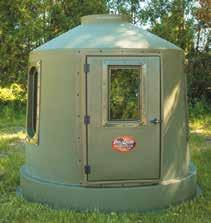

• AG VENTURE FEED & SEED
Watkins, MN • 320-764-9910
•HWY FEEDS
Platteville, WI • 608-744-2444
• SHELDON POWER & EQUIP. Sheldon, IA • 712-324-4455
•INWOOD HATCHERY Inwood, IA • 712-753-4736
• DAIRYLAND SUPPLY Sauk Centre MN • 320-352-3987





• LINDELL SALES & SERVICE Cannon Falls, MN • 651-258-4311
• LEEDSTONE Melrose, MN • 800-996-3303
•SIOUX NATION VET SUPPLY Marshall, MN • 507-532-3716
•PIERZ CO-OP Pierz, MN • 320-468-6655
•RON MILLER Waconia, MN • 952-442-4808


•FLOODWOOD FARM & FEED Floodwood, MN • 218-476-2233
• BJERGA FEED Motley, MN • 218-352-6383
• FEDERATED CO-OPS Princeton, MN • 763-389-1567
• GORTER’S CLAY & DAIRY EQUIPMENT, INC. Pipestone, MN • 507-825-3271

• ADKINS EQUIPMENT
Detroit Lakes, MN • 218-847-2079
•GERTKEN’S SALES Richmond, MN • 320-597-2207
• FARMER’S CO-OP Lafayette, MN • 507-228-8224
• AGRI-TECH Watertown, SD • 605-882-7015 Brookings, SD • 605-692-0955
• GILMAN CO-OP CREAMERY Gilman, MN • 320-387-2770
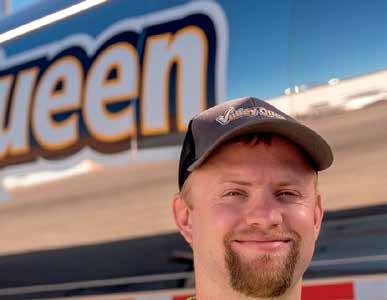

























Advanced Ag Products
Ag Processing, Inc.
Agri Feed International, LLC.
Agri-King, Inc.
Albers Dairy Equipment, Inc.
American AGCO Trading Co.
AMPI
4-D
A1
ABS Global
Ag
Agri-Plastics/Agri-Comfort
AgriSteel USA
Agromatic, Inc.
Agropur, Inc.
Amelicor
Anez Consulting, Inc.
Archer Daniels Midland Company
Arnolds of Kimball, Inc.
BECO Dairy Equipment
Bio-Vet Inc.
Bovine Hoof Adhesives/Glue-U Inc.
Butler Machinery Company


































Technologies
Valley Dairy Supply Inc.
Cloverdale Equipment LLC.
Corteva Agriscience MCS, LLC
- Dairyland Seed
Dairy Farmers of America
Calf-Tel
Dairyland Laboratories
DairyVisor, Inc.
DBC
FERA Diagnostics and Biologicals Corp.
Heartland Builders Co.
Lawley’s
MGK Insect Control Solutions
Micro Technologies and MWI
Animal Health
CHS - Animal Nutrition
Post Equipment Company/ Herd-Boss
TLAY Dairy Video Sales
Valley Dairy Farm Automation Inc.
Jones-Hamilton Co.
Kooima Ag
Lange Ag Systems, Inc.
Legend Rubber Inc.
Maas Energy Works
MB Nutritional Sciences, LLC.
MEDA/Chemstar & Milk-Rite USA
milc Group
Minnesota Department of Agriculture
MTech Dairy Solutions
Norbco
NovaMeal by Novita Nutrition
Novus International
NuAge Builders
Nuhn Industries Ltd.
Parnell Living Science
PEAK Forage Solutions Inc.
Pioneer Seeds
QualiTech, LLC.
Real-Tuff, Inc.
Safe-Trac Grooving
smaXtec Inc.
Steuart Labs
TranSource Truck & Equipment Inc.
Udder Comfort Inc.
Udder Health Systems
Udder Tech Inc.
Valley Queen Cheese
VES-Artex
Vetagro Inc.
Zero Tolerance/Current Defense
March 25 - 27, 2025
Sioux Falls, South Dakota
By Tiffany Klaphake tiffany.k@dairystar.com
RUTHTON, Minn. — For the DeRuyter family, the Wednesday of the last week in March is known as the day they get to attend Central Plains Dairy Expo.
Rich and Stephanie DeRuyter and their family milk 85 cows at their farm near Ruthton.
“We always go (to Central Plains Dairy Expo),” Stephanie said. “Our boys were just little when we started going and now our oldest is in his 30s. I don’t think we have missed a year since we started going. It’s kind of a big deal for us.”
Rich and Stephanie have seven children — Levi,
Dylan, Isaiah, Sierra, Clay, Sadie and Kai. Three are still at home and help around the farm. The oldest four are grown and work at jobs off the farm. Twenty-year-old Clay is farming full time, milking the cows twice a day and taking care of calf chores.
Stephanie helps milk in the evenings and Rich does all the feeding and cleaning. The two youngest children help as needed outside of school.
No matter what is happening on the farm, the last week in March the family sets aside one day to make the drive to Sioux Falls, South Dakota.
“We always take the kids,” Stephanie said. “The kids just love the trade (show) and walk around. It is such a safe environment for them; I never have to worry about them.”
Rich agreed.
“It’s like a eld trip for them,” Rich said. “They enjoy it as much as we do.”
Turn to DERUYTERS | Page 2







• On Site Nutritionists and lab
• NFTA certified NIR forage lab
• Nitrate testing
• Complete lines of stock products
• Custom blending for any operation
• Minimal turnaround time
• Fleet of bulk and van delivery trucks

• Dairy, Beef Cow, Poultry, Swine, Goat supplements and Minerals
• Ranchers Choice Tubs and Crystalyx Tubs
• Milk Replacers
There are many reasons the DeRuyters attend the show every year. They said they like to learn about new products and technology in the dairy industry, attend their processor’s annual meeting, visit with other farmers, and enjoy the dairy products available throughout the show.
“The part we enjoy the most is walking around visiting with other farmers,” Stephanie said. “We end up running into so many farmers that we know.”
it all in.”
Stephanie said a number of sales representatives recognize their family and always stop them to catch up.
For the DeRuyter family, there is a lot to do while at the show and they make sure to take in as much as they can.









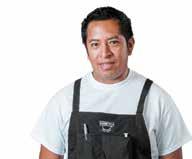


Always having young children with them, the family does not attend a lot of the seminars at CPDE but nds it valuable to visit exhibitors at the trade show. They have purchased and learned about new products to benet their farm over the years of attending CPDE.
“We are always seeking new information or products to benet our dairy so we really look forward to going to the trade show and visiting with the representatives. We just come for the day and take it all in.”
STEPHANIE DERUYTER, DAIRY FARMER
“We are always seeking new information or products to benet our dairy so we really look forward to going to the trade show and visiting with the representatives,” Stephanie said. “We just come for the day and take
“We always get ice cream and the grilled cheese sandwiches,” Stephanie said. “The kids are always excited when they get home to go through their bags of goodies.”
Taking time off the farm to learn about the latest products and technology as well as visiting with other farmers at Central Plains Dairy Expo is why the DeRuyter family will continue to attend the annual show.
“No matter how busy things get we always end up going,” Stephanie said. “It’s worth going to see what is out there for new stuff and visit with different sales reps, feed companies and other farmers.”




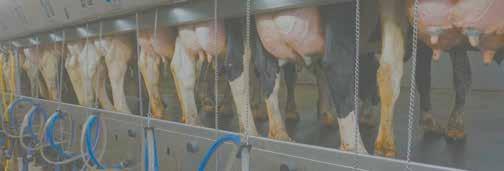
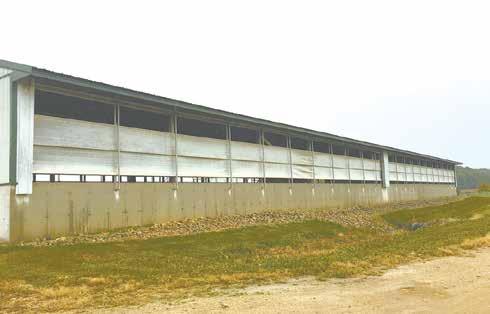
























By Danielle Nauman danielle.n@dairystar.com
When extreme weather conditions cause cows stress, a dairy farmer’s stress levels tend to rise as well, so every tool to combat stressors placed on the cows is of value to both parties.
Dr. Bill Stone, a member of Diamond V’s technical support and eld research team, will help dairy farmers ll their toolboxes with his Central Plains Dairy Expo presentation, “Cool Cows, Thriving Herds: Advanced Heat Mitigation Techniques,” held March 27 at noon in the Ed Shed.
“Heat stress signicantly impacts the dairy industry, affecting both cow performance and protability,” Stone said. “Everything we can do to minimize that stress will have a positive impact.”
Maintaining cow comfort as much as possible during times of duress can help maintain feed intake and production while reducing potential reproductive issues, Stone said.
The use of fans and water to cool cows has long been one of the best tools dairy farmers have.
“Fans and water are generally effective ways to help cows cope with the environment,” Stone said. “It
bothers me to see sprinklers wet the pens and not the cows. The focus needs to be on efcient ways to use water while cooling cows.”
Keeping the cows’ living environment clean and dry is paramount, he said.

“Excessive water usage by sprinklers can lead to wet and sloppy pens, especially in 6-row barns,” Stone said. “That leads to dirty cows, wet stalls, and potentially more mastitis and foot issues. I want to share ideas on how we can keep cows cool while keeping their environment as clean and healthy as possible.”
Beyond mechanical means to control the environment, Stone said he will address a variety of ration strategies, providing tools to nutritionally combat heat stress at a metabolic level.
Among the information Stone plans to share are new tools that can help cows be more productive and healthier while dealing with heat stress.
Stone said he is excited to share a product new to the Diamond V line that he believes will give farmers and their cows a boost in the heat stress battle — Diamond V Ice Plus.
Turn to STONE | Page 5


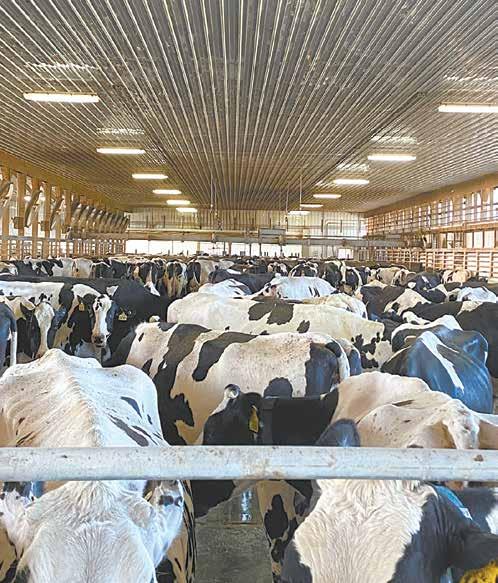
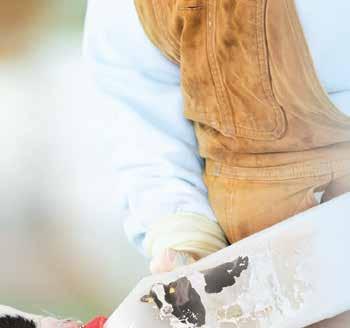
















future is now. And it starts with her. Help her maintain normal digestive health and support a functioning immune system with First Arrival® total eubiotics. This easy-to-feed product is available in powder or paste. Kickstart tomorrow’s production today.

“Ice Plus is a synergistic mix of ingredients that help cows to better handle heat stress,” Stone said. “It’s another tool to add to our toolbox when it comes to combating heat stress.”
The feed additive combines an osmolyte that promotes cellular hydration along with antioxidants and other components that minimize cellular damage and improve cellular function, Stone said.
While traditional electrolytes can help prevent and reverse vascular dehydration, the osmolytic properties of the additive help hydrate cows at the cellular level, keeping cellular damage during heat stress at a minimum.
“We have observed a reduction in body temperature in three eld trials with Ice Plus,” Stone
“Ice Plus is a synergistic mix of ingredients that help cows to better handle heat stress. It’s another tool to add to our toolbox when it comes to combating heat stress.”
DR. BILL STONE, DIAMOND V
said. “We think this could be happening from a few different mechanisms. The additive helps the cow more efciently cool herself.”
Stone said when an animal is properly hydrated, the widening of its blood vessels is more effective, allowing cells to function normally. Reduced damage to cellular components such as proteins and lipids can lessen the heat that would have been generated from the necessary cellular repair or replacement.
Reproductive health and performance suffer alongside production losses when heat stress occurs, Stone said. Embryonic damage or delayed development can occur in cows experiencing heat stress.
“Keeping a cow well hydrated protects cellular health and ultimately can help keep her body temperature a bit lower,” Stone said. “This encourages some additional feed intake as well. We have several eld trials where the cows being fed Ice Plus lost less milk and had improved reproductive performance as compared to the control cows.”
Cool Cows, Thriving Herds: Advanced Heat Mitigation Techniques
March 27 at noon in the Ed Shed.


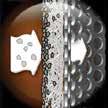











BROOKINGS, S.D. — The 2025 Midwest Regional Dairy Challenge, hosted by South Dakota State University concluded Feb. 14 in Brookings. The event saw signicant participation with 110 students from 13 schools, along with coaches and volunteers for an immersive learning experience.
The Midwest event is one of four regional contests sponsored each year by North American Intercollegiate Dairy Challenge. These regional contests — plus a national event for about 250 dairy colleagues — are funded through support of 130 agribusinesses and dairy producers. Dairy Challenge has helped prepare over 10,000 students for careers as dairy owners or managers, consultants, researchers, veterinarians or other dairy professionals.
The mission of NAIDC is to develop tomorrow’s dairy leaders and enhance the progress of the dairy industry, by providing education, communication and networking among students, dairy producers, agribusinesses and university personnel.
Upon arrival, students attended educational seminars covering nancial management, automatic milking systems and emerging farm technology. They also had the opportunity to meet their mentor and teammates over dinner, followed by a brief teambuilding activity. Afterwards, teams received farm information and began analyzing data in preparation for their farm visit on Feb. 13 and their upcoming presentation.
On the second day, students visited MoDak Dairy Inc., where they toured the calf and heifer barn, lactating barn and milking parlor. Guided by industry mentors, teams assessed various aspects of each facility at the dairy farm, including animal health, parlor management, transition pens and feed management processes. Additionally, student teams conducted interviews with the producers to gain deeper insights into farm management practices and goals. In the afternoon, teams used the data collected to develop their presentations. After submitting their work, all attendees, volunteers and coaches gathered for dinner and a networking event.
The nal day of the contest featured team presentations, evaluated by a panel of judges. Each team delivered a 20-minute analysis outlining the strengths and areas of improvement of the farm they had assessed. Additionally, students were able to attend a career and innovation fair, and educational sessions, including a Dairy Challenge alumni panel and an informational session entitled “The Future of Dairy Products” presented by Dr. Prafulla Salunke, a professor at SDSU. The event concluded with the presentation of student awards, marking the end of the 2025 Midwest Regional Dairy Challenge.
A total of eight teams placed. The judges awarded teams the rst and second place rankings on each farm among the 24 total teams participating.

Team Number 5 — Ailish Koerpel, South Dakota State University (front, from le ) and Abbygail Foster, Southwest Wisconsin Technical College; (back, from le ) Emma Mathison, University of Wisconsin—Madison and Tyler Machin, Iowa State University — gathers at the Midwest Regional Dairy Challenge in Brookings, South Dakota. The team placed rst for Panel A.

PHOTO SUBMITTED
Team Number 17 — Sydney Haag, Purdue University (front, from le ) and Addie DeMars, Southwest Wisconsin Technical College; (back, from le ) Regan Kramer, Iowa State University; Cael Gooding, University of Wisconsin—River Falls and Aubree Topp, Northeast Iowa Community College — gathers at the Midwest Regional Dairy Challenge in Brookings, South Dakota.

Team Number 11 — Courtney Glenna, University of Wisconsin—River Falls (front, from le ) and Jenna Heeringa, Dordt University; (back, from le ) Delana Erbsen, Iowa State University and Isaiah Eisert, Purdue University — gathers at the Midwest Regional Dairy Challenge in Brookings, South Dakota. The team placed rst for Panel B. Not pictured, Rhe Vander Dussen, Kansas State University.





The team placed rst for Panel C.
Team Number 23 — Emma Mulhern, South Dakota State University (front, from le ) and Payton Van Schnydle, University of Wisconsin—Pla eville; (back, from le ) Megan Mosgaller, University of Wisconsin—Rivers Falls; Owen Pritche , College of the Ozarks and Irene Nielsen, Iowa State University — gathers at the Midwest Regional Dairy Challenge in Brookings, South Dakota. The team placed rst for Panel D.


































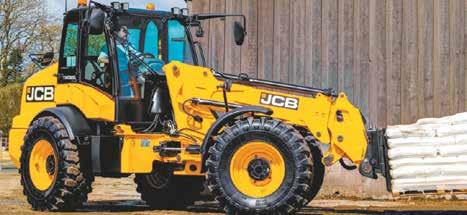








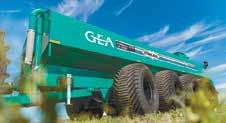






















































Increase the longevity of your electric pump in sand-intensive environments by choosing a GEA Tuff built pump. It will help reduce downtime, lower maintenance costs, and enhance overall operational efficiency and profitability.
Contact your local GEA Manure Equipment Dealer for more information.
Easy and cost-effective retrofit for existing pumps.







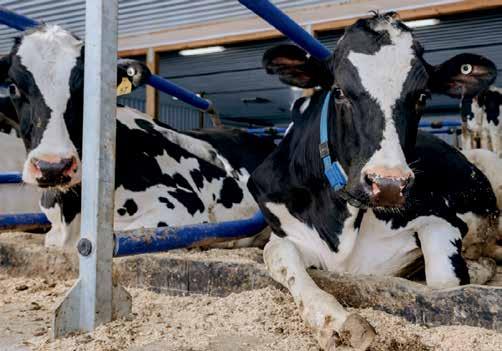
By Sherry Newell Staff writer
For a long time, nutritionists, dairy farmers and managers have known the importance of increased attention to cows during the transition period.
Ruby Wu, dairy technical manager for Arm and Hammer Animal and Food Production, will be presenting at a Central Plains Dairy Expo breakout session March 26 at 3:30 p.m. and March 27 at 8:30 a.m. Her presentation, “Feeding for Resilience: Overcoming Health Challenges Throughout a Cow’s Life Cycle,” will explore the latest research surrounding transition cow management, and offer practical solutions for meeting cows’ needs during this important time. This will include discussion of the changing dietary cation–anion difference numbers to aim for while working with prefresh and postpartum cows.
DCAD measures the levels of macro minerals in the diet, tracking potassium and sodium versus chloride and sulfur.

Ruby Wu Arm and Hammer Animal and Food Production
“The value of DCAD has been changing,” she said. “There were educators in the past talking about a -20 (pre-fresh) DCAD, whereas now we’re thinking more like a -8 to -12.”
The negative DCAD helps mobilize calcium at calving and helps decrease postpartum metabolic disorders while increasing feed intake and milk production, she said. Monitoring urine pH is one way to keep tabs on the right chemical analysis of feed ingredients and forages.
Then at postpartum, Wu said DCAD should be +35 to +45.
“A lot of things need to be done to limit difficulties in close-up and fresh cows. The transition period is the most critical and complex phase in a dairy cow’s life.”
RUBY WU, ARM AND HAMMER ANIMAL AND FOOD PRODUCTION
“A lot of things need to be done to limit difculties in close-up and fresh cows,” Wu said. “The transition period is the most critical and complex phase in a dairy cow’s life.”
She said dairy farmers may have had a classic way of feeding, but new knowledge and new technology have opened the door to broader thinking about preventing disease while maximizing productivity. The changing views on DCAD are among those that have emerged.


“It’s not just a number you write,” Wu said.
She said getting the proper balance in a ration can help a cow reach her best performance.
“In the meantime, it’s important to stay on top of cow management overall, and push feed,” she said. “Obviously, DCAD is just one piece of the picture.”
When it comes to nutrition, Wu said she continues to wish for more data about the Jersey breed. At present, most researchers use Holsteins because of their availability.
“Biologically, they’re the same,” she said. “But in application, they are slightly different.”
Wu also will discuss the value of increasing metabolizable protein in the close-up cow diet. Recent thinking has moved nutritionists toward higher MP versus crude protein. Her recommendation is 1,300 grams of MP per cow per day for close-up animals.
“MP is the one animals can really use, really absorb,” she said.
While Wu said her recommendations reect recent research that can help guide cows’ transition diets, she also said more study is needed to help understand how to boost immune status in cows.
March 26 at 3:30 p.m. in room Mr 1/2 and March 27 at 8:30 a.m. in room MR 13






























By Sarah Middendorf sarah.m@star-pub.com
Homegrown feeds normally reduce feed costs and market risks. Growing high oleic soybeans is an opportunity to provide valuable fat and protein for cattle diets.
Kevin Harvatine, professor of nutritional physiology at The Pennsylvania State University, will be presenting “Do High Oleic Soybeans Fit Your Farm? Research and Producer Panel Discussion” March 26






at 11 a.m. and March 27 at 9:30 a.m. during the Central Plains Dairy Expo in Sioux Falls, South Dakota.
In his presentation, Harvatine will talk about high oleic soybean research and how the product ts into dairy rations. Two dairy producers — Nathan Brandt and Tim Hood — will speak about their practical, onfarm experience with the soybeans.
Harvatine said normally farmers are focusing on forages and grains to provide protein and not necessarily focusing on growing their own fats.
“Growing high oleic soybeans provide the op-

portunity to control some of the fat side of the diet,” Harvatine said.
Soybeans often are an economical source of fat and protein. However, they are high in unsaturated fatty acids that increase the risk of rumen upset and milk fat depression. High oleic soybeans have been around for nearly a decade but have seen a rapid increase in dairy rations over the past two years as they have gained popularity Harvatine said.
Oleic is an unsaturated fatty acid with a single double bond. These soybeans were originally developed to provide specialty oils for human consumption as they are more stable and have a longer fry life.
“The rapid adoption in dairy rations is because oleic acid (18:1 fatty acid) is lower risk than 18:2,” Harvatine said. “(18:2) is the fatty acid that puts us at really high risk for milk fat depression. The high cost of other fat sources and competition with biofuels over the past few years has also driven interest in other sources of dietary fat.”
Harvatine stressed the importance of correctly using high oleic soybeans in diets. Since these soybeans provide both fat and protein, the ration will need to be optimally balanced for both nutrients.
“To me it’s kind of exciting because it’s what I call ‘an opportunity’ for homegrown fat and dairy farms have talked about for a long time,” Harvatine said. “Having homegrown feed to reduce feed cost is helpful.”
High oleic soybeans are a safer soybean for dairy cows because they have less risk for milk fat depression, but they are not zero risk, Harvatine said.
To best use high oleic soybeans in a ration for dairy cattle, they should be heat treated, Harvatine said. Heat treatment denatures the anti-nutritive factors naturally in soybeans as well as increases the amount of protein that will bypass the rumen.
After roasting, soybeans should be broken, targeting quarters to halves, which balances slowing rumen degradation without decreasing digestion in the intestine. Harvatine said care needs to be taken with grinding further than this because it increases the release of the fatty acids in the rumen and increases the risk of milk fat depression.
Harvatine said roasting equipment is a good investment for cattle owners feeding full-fat soybeans, such as high oleic soybeans.
“We are actually adding some value to that protein,” Harvatine said. “It’s not just being chewed up in the rumen. We are actually getting higher bypass.”
The other way to process the soybeans is through an expeller press. This process will crush the soybeans, and the byproduct left is called expeller meal. Harvatine said this meal will be about 7%-8% fat.
Being able to grow high oleic soybeans to feed the herd can help cut down feed costs. Harvatine said if farms have the acreage to grow their own soybeans, they have the option to grow high oleic soybeans. He said he also has seen farmers in his area contract high oleic soybeans through their crop-farming neighbors.
“It’s really neat because it’s really a decision that has to be made farm-by-farm,” Harvatine said.
Do High Oleic Soybeans Fit Your Farm? Research and Producer Panel Discussion March 26 at 11 a.m. in room MR 1/2 and March 27 at 9:30 a.m. in room MR 1/2


By Emily Breth emily.b@star-pub.com
Finding better ways to care for calves and keep them healthy has always been of importance for dairy producers as they are raising their future herds. Mike Nagorske will be discussing how to do this at 10 a.m. March 26 in room MR 8 and March 27 at 11 a.m. in room MR 12 at the Central Plains Dairy Expo in Sioux Falls, South Dakota.
Nagorske said the presentation will be fairly focused on the treatment of scours. He will discuss a novel treatment of utilizing colostrum and what about colostrum makes it effective for the treatment of scours.
“The biggest thing is making (the presentation) actionable,” Nagorske said. “Farmers can get a lot of technical stuff thrown at them and I don’t want them not making an actionable plan and taking action.”
Nagorske said he plans to provide statistics on future milk production and the cost of not preventing scours. He also wants to give farmers knowledge of what they can do on

their farm for prevention and treatment.
The main reason Nagorske said it is important for farmers to attend this session is to gain


information for creating a plan. He will provide tools so farmers can better work with their veterinarians and nutritionists. “If farmers want to call me
back afterward so I can help them with a plan, that’s actionable too,” Nagorske said. Nagorske grew up on a corn, soybean and cattle op-
eration, and has operated an Angus seed stock operation



















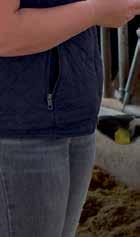



















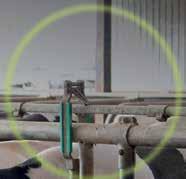




























• Balanced protein and fat sources for efficient gains
• Bio-EnVigor8 for optimal calf health and rumen development
• Encapsulated and refined particles with ideal blending characteristic for fast and easy mixing that stays in suspension







alongside his brother for about 25 years. He operated this business while earning a degree from the College of Veterinary Medicine at the University of Minnesota.
Following college, Nagorske got a start in research working for Trans Ova Genetics. In the last year he has become an independent calf consultant.
Nagorske said research shows 56% of pre-weaned heifer deaths are due to gastrointestinal illnesses.





New High-performance silicone liner IT DOES THE CHANGE-OUT FOR YOU! No more disassembly, shell washing or reloading – ever!
• Long-lasting Silicone: Service life of 6,000 - 8,000 cow milkings
• Transitional Barrel: Round-to-square for less slip, faster milk-out, improved teat health
• Intelligent Design: SAVES LABOR, TIME, MONEY
• Independently Trialed: Proven on farm
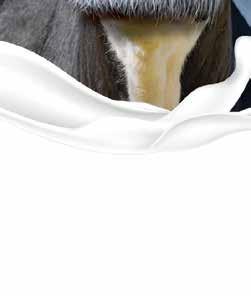

SST-Driver: The brilliant move for large-herd dairies! 800-828-9258 evolutionliners.com






one,” he said. “I’m not going to say it’s going to eliminate it completely, but at my biggest client’s calf ranch … they’ll tell you that it’s virtually eliminated. I’ve seen about 5%-7% incidence of scours, and I’m not talking death loss.”


Dr. Michael Nagorske
“If we look at that and focus specically on calves, … scours is like a bottleneck,” Nagorske said. “In most programs, we have something that we can use to combat that.”
Nagorske said he plans on pointing out things he has seen in the eld and share on-farm data pertaining to how colostrum affects calf health. Among the angles for improved calf care he will present is better use of milk with colostrum.
“I want them to be able to look at their milk nutrition and maybe ask themselves, ‘Am I doing the right thing?’” Nagorske said. “What are some options and what they can do? From the presentations I’m going to point to the use of sellable whole milk.”
Nagorske will show research that has been done around the use of colostrum in both cattle and humans and the benets it has. In some cases, supplementing dried colostrum into milk replacer has shown a great benet to calves, Nagorske said.
“I’ve seen pretty minimal scours cases when colostrum is used post day


Throughout the presentation, he will also talk about the effect hospital milk can have on calves and the difference hospital milk makes on a younger calf versus an older one. He will discuss a correlation of cases of scours on farms which utilized hospital milk for their young stock.
Calf health and care will continue to evolve and improve through variations of research and studies. However, Nagorske said it is important to focus on what can be used from things produced on the farm.
“Scours can be prevented and treated by products that are not synthesized in a lab,” Nagorske said. “It’s a farmer’s colostrum that can be utilized to its full potential.”
March 26 at 10 a.m. in room MR 8 and March 27 at 11 a.m. in room MR 12





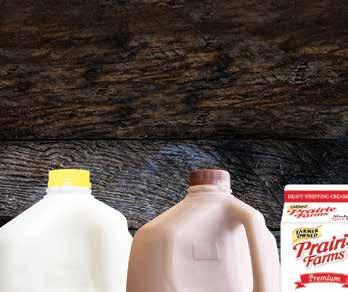










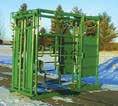


















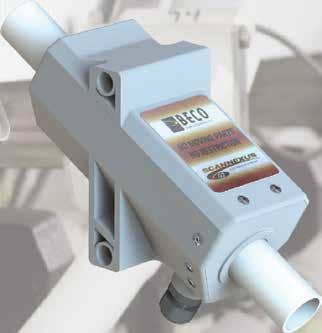










By Michele Ackerman Contributing writer
A cow’s ability to regulate blood calcium in the days following calving can set her up for success — or failure — for the rest of her lactation. If she cannot effectively maintain serum calcium and it dips too low, she will experience subclinical hypocalcemia. If symptoms become clinical, she will suffer from milk fever.
New research shows that it is not just the level of serum blood calcium postpartum that determines a cow’s fate for negative events. The speed of recovery plays a role too, said Dr. Claira Seely, an assistant professor at the University of New Hampshire.
at one day in milk and again at four days in milk.”





Dr. Claira Seely University of New Hampshire
Cows in the last two categories, with low levels of blood calcium at four days in milk, experience the most downstream negative outcomes Seely said. Since there are no cow-side tools to diagnose subclinical hypocalcemia, producers can try to nip subclinical hypocalcemia in the bud through dietary strategies in the close-up dry period.
“A negative dietary cation-anion difference diet acidies a cow and primes her calcium-modulating mechanisms,” Seely said. “When she calves and starts producing milk, her body is already ready to get going and to mobilize all the calcium she can to maintain blood calcium status.”
Calcium binders in the dry cow ration are another option.
March 26 at 11 a.m. in MR 14 and March 27 at 1 p.m. in MR 13


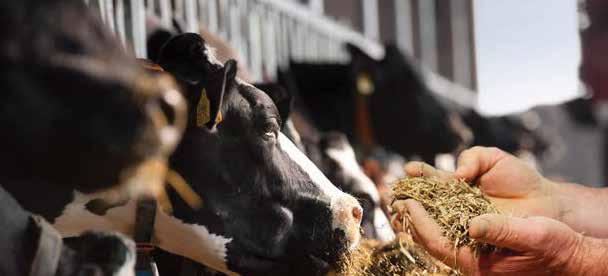
Seely will discuss this research in her presentation, “Prevention and Treatment of Subclinical Hypocalcemia to Optimize Health and Reproduction in Dairy Cattle,” at 11 a.m. March 26 and 1 p.m. March 27 at Central Plains Dairy Expo in Sioux Falls, South Dakota. She will also give producers practical strategies to prevent subclinical hypocalcemia postpartum.
Seely said subclinical hypocalcemia is an important disease because it is invisible and affects about 30% of cows.
“In the beginning, we don’t even know a cow has the disorder because we can’t see it,” Seely said. “These cows appear ne. They go back to the feed bunk, get milked, and look OK.”
She said historically, subclinical hypocalcemia — a reduction in blood calcium beyond the normal range — has been diagnosed as total serum calcium levels ranging from 7.2—8.8 mg/dL in the rst 24 hours after calving.
That static snapshot, however, does not tell the whole story. Whether the drop in blood calcium becomes problematic depends on when it drops, and for how long.
“There are four classic variations of blood calcium, four avors of subclinical hypocalcemia, and the fates of each are different,” Seely said.
Cows in the rst category, categorized as normal, do not experience a dramatic reduction in blood calcium after calving. They seem ne and blood calcium just keeps on chugging away Seely said.




The second category is cows with transient subclinical hypocalcemia.
“At one day in milk, these cows experience the classic drop in blood calcium, but by four days postpartum, blood calcium is back up,” Seely said. “This is nothing to be concerned about, and these cows continue to a productive lactation.”
With the group she said she calls delayed, blood calcium is high on day one, but by day four, it is low.
“Finally, we have persistent subclinical hypocalcemia,” she said. “These cows experience reduced blood calcium
“This articially reduces blood calcium in circulation, so a cow is already in a state of lower calcium,” Seely said. “Once she calves and goes off the calcium-binding diet, she is making milk, and her body is already used to being in a calcium decit. She is better able to deal with the pull of calcium into milk production.” Producers also have options to treat subclinical hypocalcemia postpartum.
“If you suspect a cow has subclinical hypocalcemia, you can give oral calcium boluses,” Seely said. “Give one at calving and then another a day later. This is a common blanket therapy many producers implement.”
However, Seely said studies show calcium boluses may not be entirely effective.
She also cautioned dairy producers about treating cows that have not been diagnosed with milk fever.
“We do not encourage farmers to give intravenous or subcutaneous calcium to cows that are not experiencing clinical milk fever,” Seely said. “Research shows this will exacerbate the calcium homeostasis imbalance. Cows will rebound and have very, very low calcium after giving them a bottle of calcium if they are not experiencing clinical milk fever.”
Mature cows deserve special attention along with cows that had difcult calvings in the past or experienced milk fever in previous lactations.
“These cows are at greater risk of developing subclinical hypocalcemia so they might be good candidates for oral calcium supplements postpartum,” Seely said.
How does a producer know if they have a problem with subclinical hypocalcemia?
“If you are experiencing cows with reduced blood calcium at four days in milk in more than 30%-33% of fresh cows, then there is something going on,” Seely said. “That is when you need to look at the dry cow ration and take a closer look at your transition cow program.”

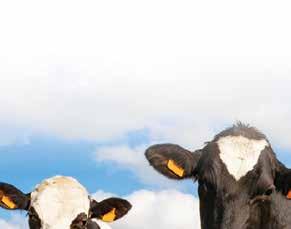








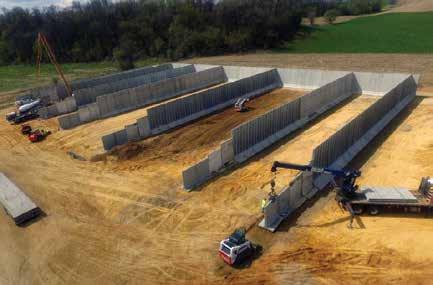



































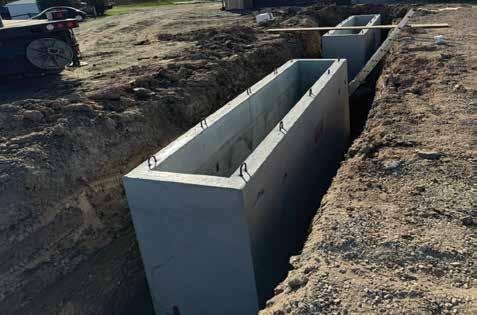

















A endees walk through the trade show March 20, 2024, at Central Plains Dairy Expo in
Falls, South Dakota. In 2024, 3,573 dairy producers and allied industry representa ves a ended CPDE.
(le ) The Maus family Jus n (from le ), James, Damian, Lynnea, Jenn and Alex — smile March 20, 2024, at Central Plains Dairy Expo in Sioux Falls, South Dakota. The Maus
90 cows near Osakis, Minnesota.




